SPECIAL TOPIC—Machine learning in biomolecular simulations
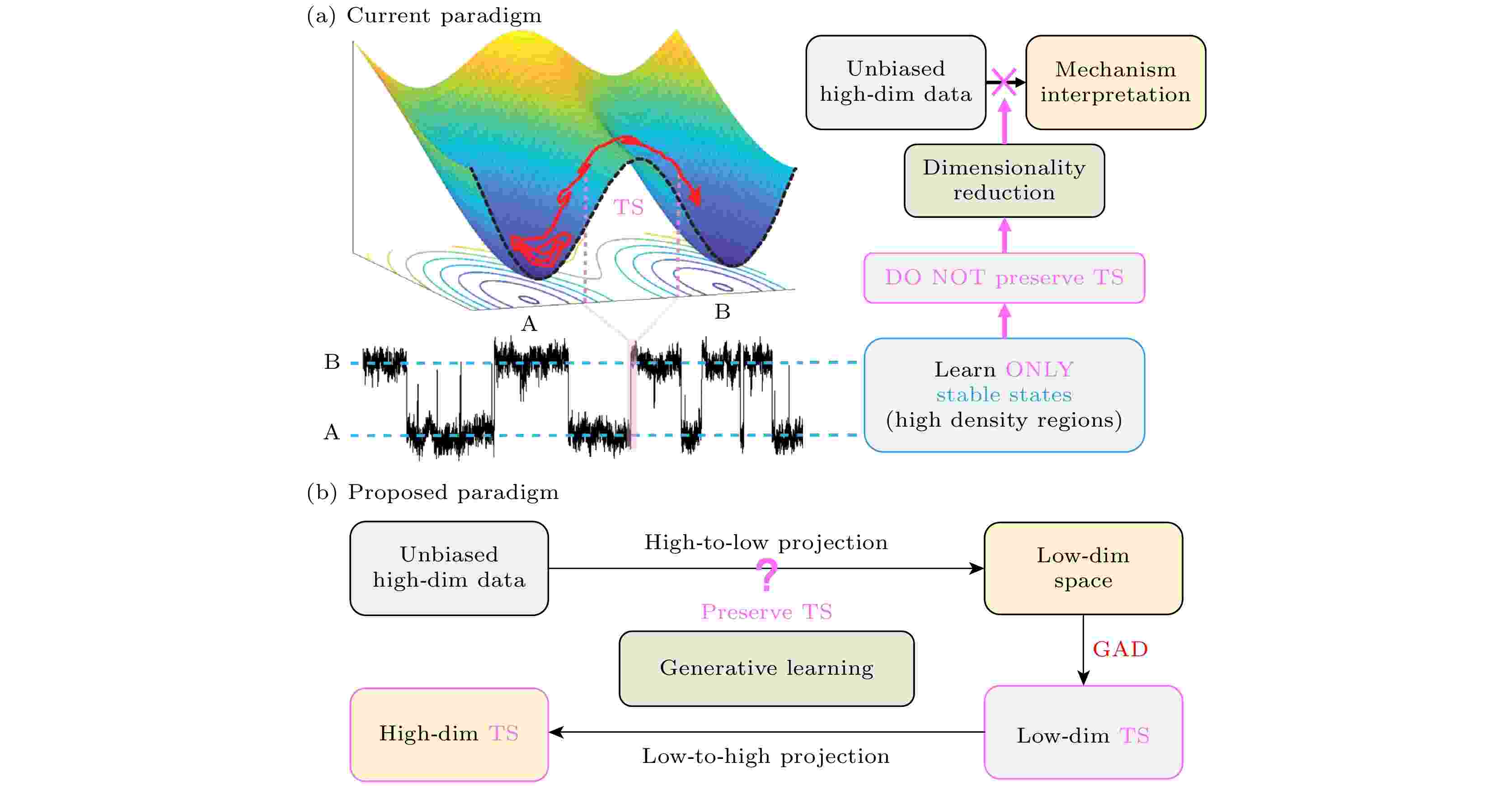
2023, 72 (24): 248701.
doi:10.7498/aps.72.20231319
Abstract +
Transition state is a key concept for chemists to understand and fine-tune the conformational changes of large biomolecules. Due to its short residence time, it is difficult to capture a transition state via experimental techniques. Characterizing transition states for a conformational change therefore is only achievable via physics-driven molecular dynamics simulations. However, unlike chemical reactions which involve only a small number of atoms, conformational changes of biomolecules depend on numerous atoms and therefore the number of their coordinates in our 3D space. The searching for their transition states will inevitably encounter the curse of dimensionality, i.e. the reaction coordinate problem, which invokes the invention of various algorithms for solution. Recent years, new machine learning techniques and the incorporation of some of them into the transition state searching methods emerged. Here, we first review the design principle of representative transition state searching algorithms, including the collective-variable (CV)-dependent gentlest ascent dynamics, finite temperature string, fast tomographic, travelling-salesman based automated path searching, and the CV-independent transition path sampling. Then, we focus on the new version of TPS that incorporates reinforcement learning for efficient sampling, and we also clarify the suitable situation for its application. Finally, we propose a new paradigm for transition state searching, a new dimensionality reduction technique that preserves transition state information and combines gentlest ascent dynamics.
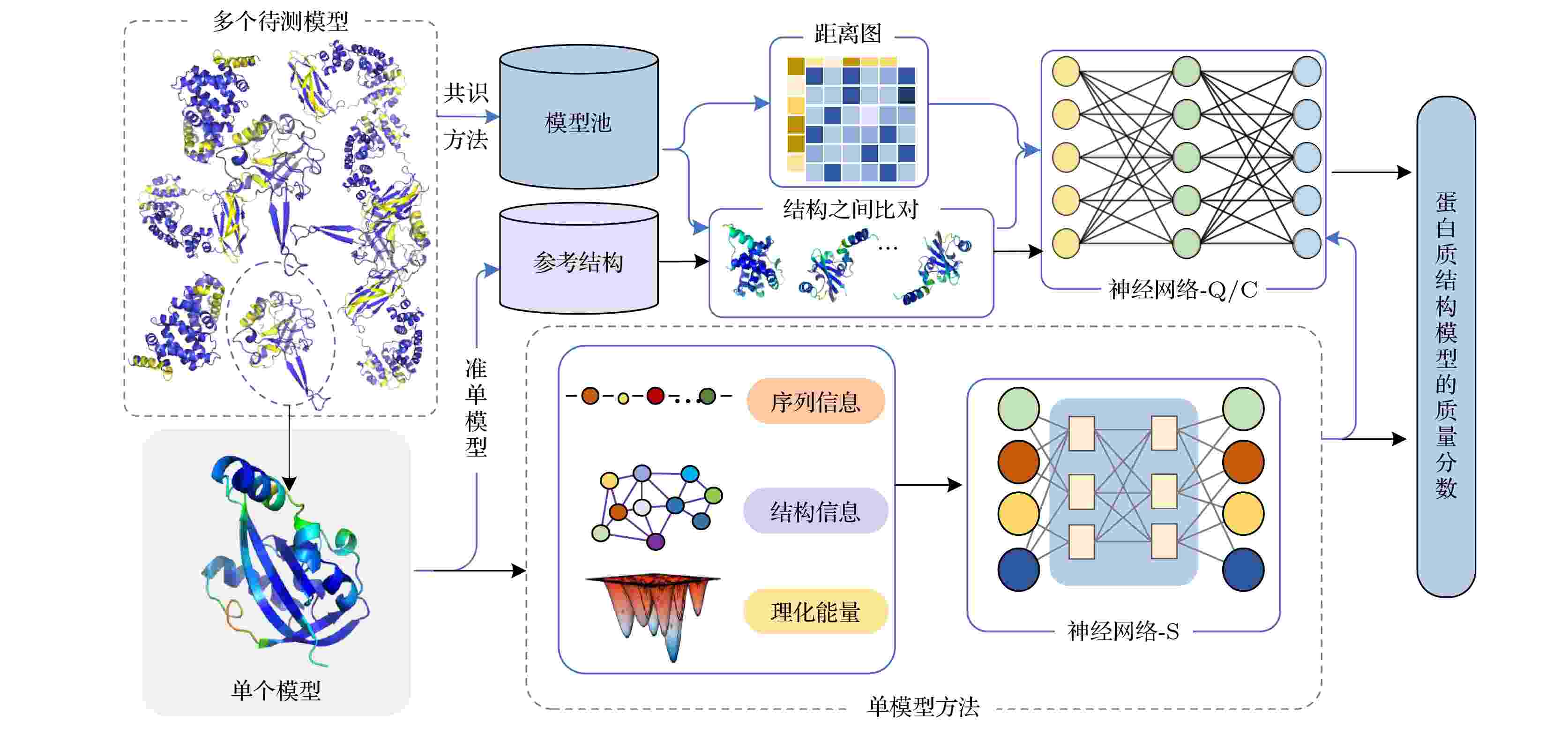
2023, 72 (24): 248702.
doi:10.7498/aps.72.20231071
Abstract +
The quality assessment of protein models is a key technology in protein structure prediction and has become a prominent research focus in the field of structural bioinformatics since advent of CASP7. Model quality assessment method not only guides the refinement of protein structure model but also plays a crucial role in selecting the best model from multiple candidate conformations, offering significant value in biological research and practical applications. This study begins with reviewing the critical assessment of protein structure prediction (CASP) and continuous automated model evaluation (CAMEO), and model evaluation metrics for monomeric and complex proteins. It primarily summarizes the development of model quality assessment methods in the last five years, including consensus methods (multi-model methods), single-model methods, and quasi-single-model methods, and also introduces the evaluation methods for protein complex models in CASP15. Given the remarkable progress of deep learning in protein prediction, the article focuses on the in-depth application of deep learning in single-model methods, including data set generation, protein feature extraction, and network architecture construction. Additionally, it presents the recent efforts of our research group in the field of model quality assessment. Finally, the article analyzes the limitations and challenges of current protein model quality assessment technology, and also looks forward to future development trends.
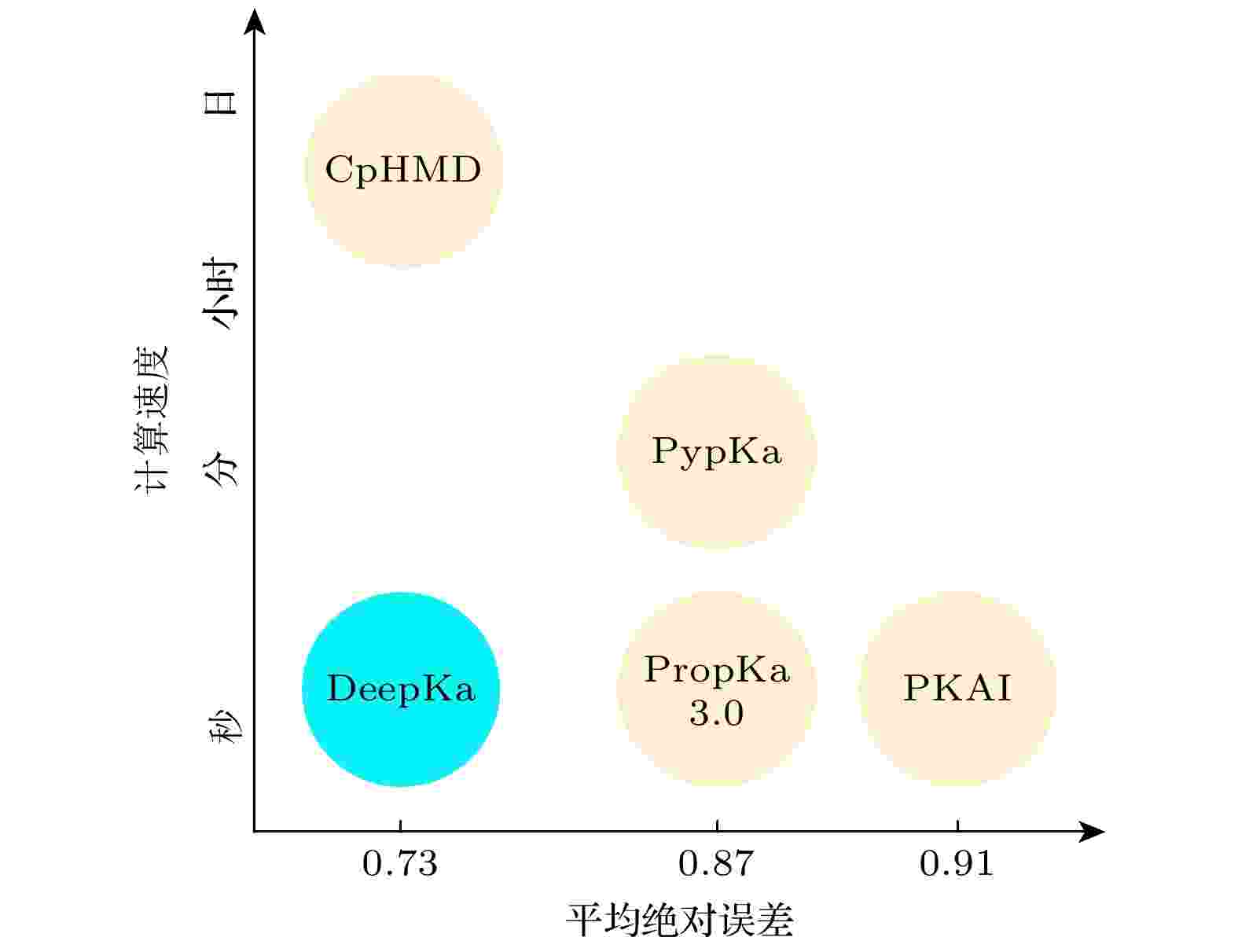
2023, 72 (24): 248704.
doi:10.7498/aps.72.20231356
Abstract +
The pH value represents the acidity of the solution and plays a key role in many life events linked to human diseases. For instance, the β-site amyloid precursor protein cleavage enzyme, BACE1, which is a major therapeutic target of treating Alzheimer’s disease, functions within a narrow pH region around 4.5. In addition, the sodium-proton antiporter NhaA fromEscherichia coliis activated only when the cytoplasmic pH is higher than 6.5 and the activity reaches a maximum value around pH 8.8. To explore the molecular mechanism of a protein regulated by pH, it is important to measure, typically by nuclear magnetic resonance, the binding affinities of protons to ionizable key residues, namely
$ {\mathrm{p}}{K}_{{\mathrm{a}}} $
values, which determine the deprotonation equilibria under a pH condition. However, wet-lab experiments are often expensive and time consuming. In some cases, owing to the structural complexity of a protein,
$ {\mathrm{p}}{K}_{{\mathrm{a}}} $
measurements become difficult, making theoretical
$ {\mathrm{p}}{K}_{{\mathrm{a}}} $
predictions in a dry laboratory more advantageous. In the past thirty years, many efforts have been made to accurately and fast predict protein
$ {\mathrm{p}}{K}_{{\mathrm{a}}} $
with physics-based methods. Theoretically, constant pH molecular dynamics (CpHMD) method that takes conformational fluctuations into account gives the most accurate predictions, especially the explicit-solvent CpHMD model proposed by Huang and coworkers (
2016
J. Chem. Theory Comput.
125411
) which in principle is applicable to any system that can be described by a force field. However, lengthy molecular simulations are usually necessary for the extensive sampling of conformation. In particular, the computational complexity increases significantly if water molecules are included explicitly in the simulation system. Thus, CpHMD is not suitable for high-throughout computing requested in industry circle. To accelerate
$ {\mathrm{p}}{K}_{{\mathrm{a}}} $
prediction, Poisson-Boltzmann (PB) or empirical equation-based schemes, such as H++ and PropKa, have been developed and widely used where
$ {\mathrm{p}}{K}_{{\mathrm{a}}} $
values are obtained via one-structure calculations. Recently, artificial intelligence (AI) is applied to the area of protein
$ {\mathrm{p}}{K}_{{\mathrm{a}}} $
prediction, which leads to the development of DeepKa by Huang laboratory (
2021
ACS Omega
634823
), the first AI-driven
$ {\mathrm{p}}{K}_{{\mathrm{a}}} $
predictor. In this paper, we review the advances in protein
$ {\mathrm{p}}{K}_{{\mathrm{a}}} $
prediction contributed mainly by CpHMD methods, PB or empirical equation-based schemes, and AI models. Notably, the modeling hypotheses explained in the review would shed light on future development of more powerful protein
$ {\mathrm{p}}{K}_{{\mathrm{a}}} $
predictors.
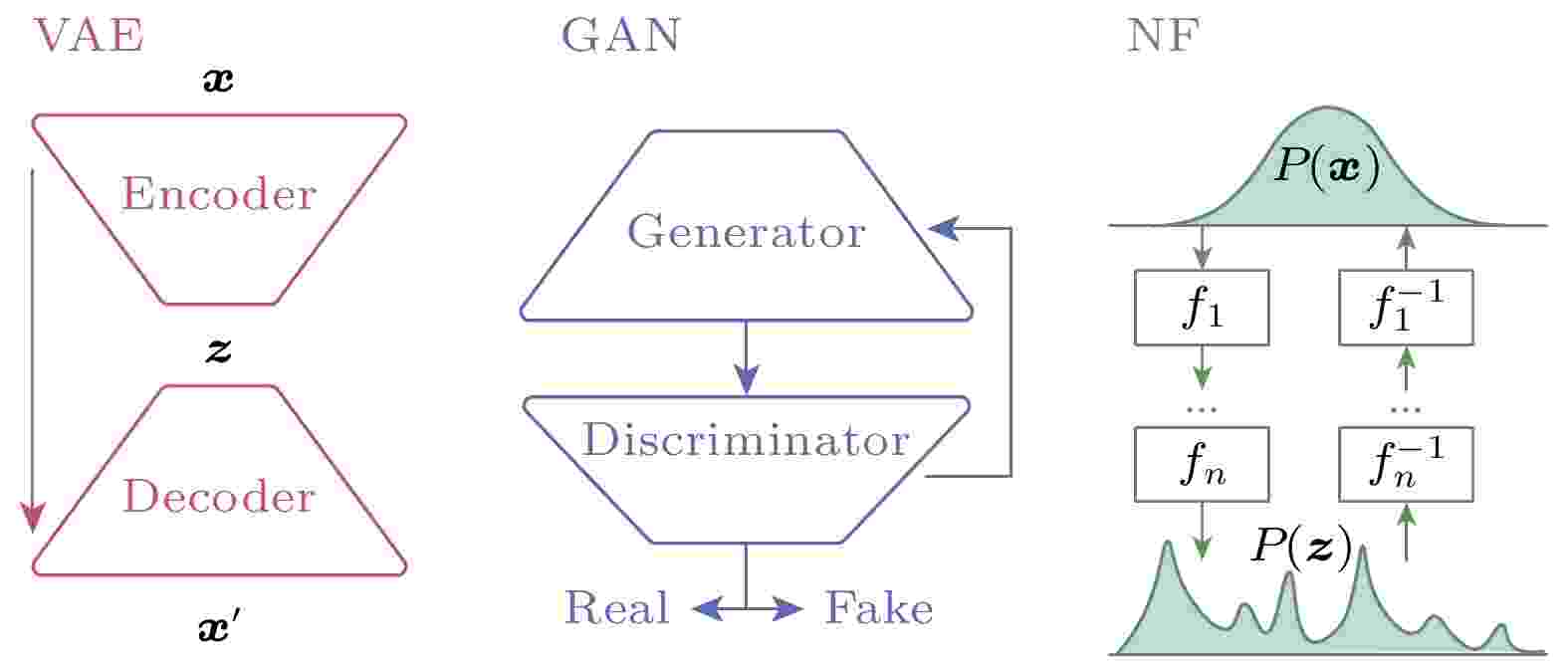
2023, 72 (24): 248708.
doi:10.7498/aps.72.20231624
Abstract +
Molecular simulation has already become a powerful tool for studying life principles at a molecular level. The past 50-year researches show that molecular simulation has been able to quantitatively characterize the kinetic and thermodynamic properties of complex molecular processes, such as protein folding and conformational changes. In recent years, the application of machine learning algorithms represented by deep learning has further promoted the development of molecular simulation. This work reviews machine learning methods in biomolecular simulation, focusing on the important progress made by machine learning algorithms in improving the accuracy of molecular force fields, the efficiency of molecular simulation conformation sampling, and also the processing of high-dimensional simulation data. The future researches to further overcome the bottleneck of accuracy and efficiency of molecular simulation, expand the scope of molecular simulation, and realize the integration of computational simulation and experimental based on machine learning technique is prospected.
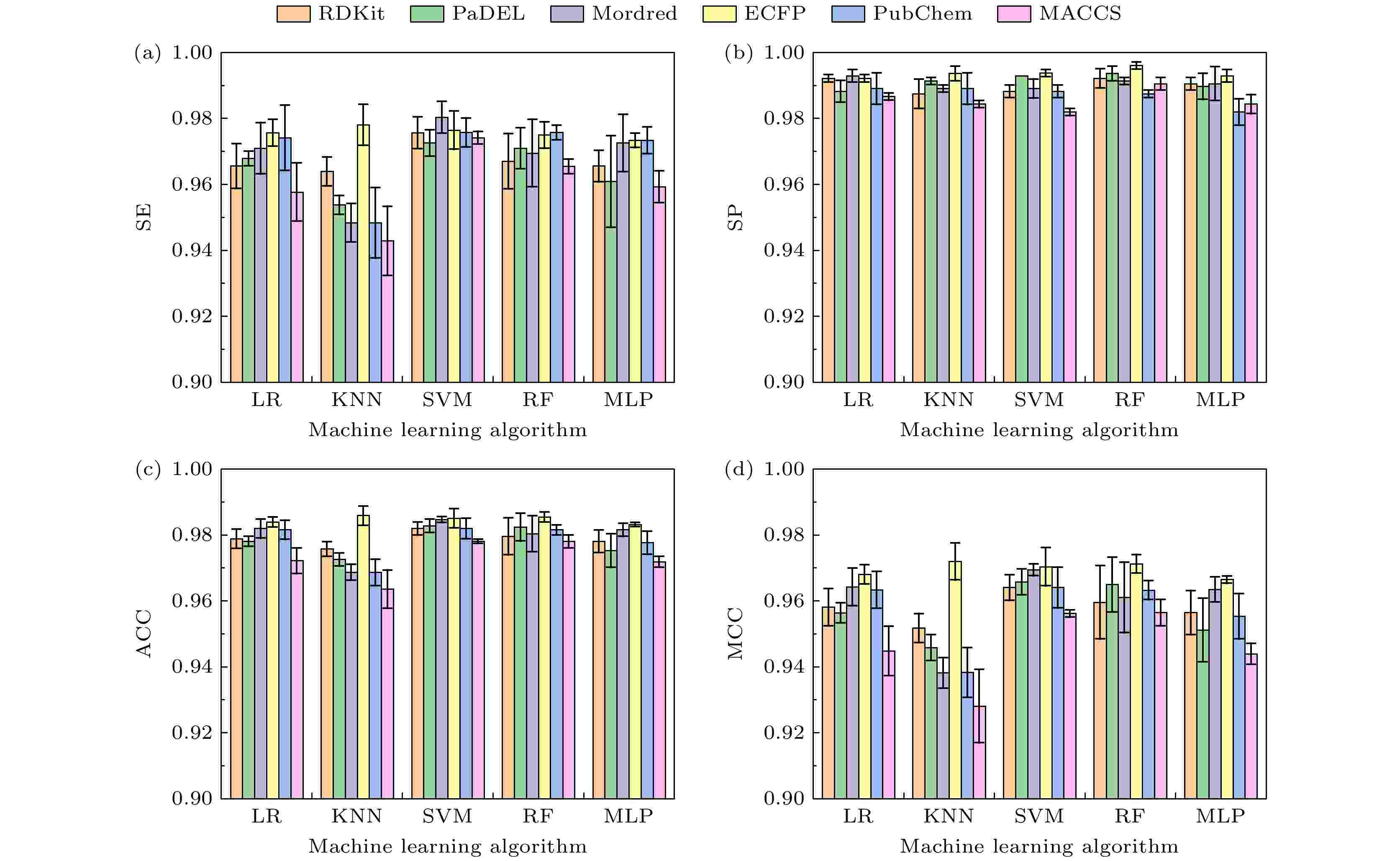
2023, 72 (24): 240501.
doi:10.7498/aps.72.20231068
Abstract +
Monoclonal antibody inhibitors targeting PD-1/PD-L1 immune checkpoints are gradually entering the market and have achieved certain positive effects in the treatments of various types of tumors. However, with the expansion of application, the limitations of antibody drugs and problems such as excessive homogenization of research gradually appear, making small-molecule inhibitors the new focus of researchers. This study aims to use ligand-based and structure-based binding activity prediction methods to achieve virtual screening of small-molecule inhibitors targeting PD-L1, thereby helping to accelerate the development of small molecule drugs. A dataset of PD-L1 small-molecule inhibitory activity from relevant research literature and patents is collected and activity judgment classification models with intensity prediction regression models are constructed based on different molecular featurization methods and machine learning algorithms. The two types of models filter 68 candidate compounds with high PD-L1 inhibitory activity from a large drug-like small molecule screening pool (ZINC15). Ten of these compounds not only have good drug similarities and pharmacokinetics, but also exhibit comparable binding affinities and similar mechanisms of action with previous reported hotspot compounds in molecular docking. This phenomenon is further verified in subsequent molecular dynamics simulation and the estimation of binding free energy. In this study, a virtual screening workflow integrating ligand-based method and structure-based method is developed, and potential PD-L1 small-molecule inhibitors are effectively screened from large compound databases, which is expected to help accelerate the application and expansion of tumor immunotherapy.
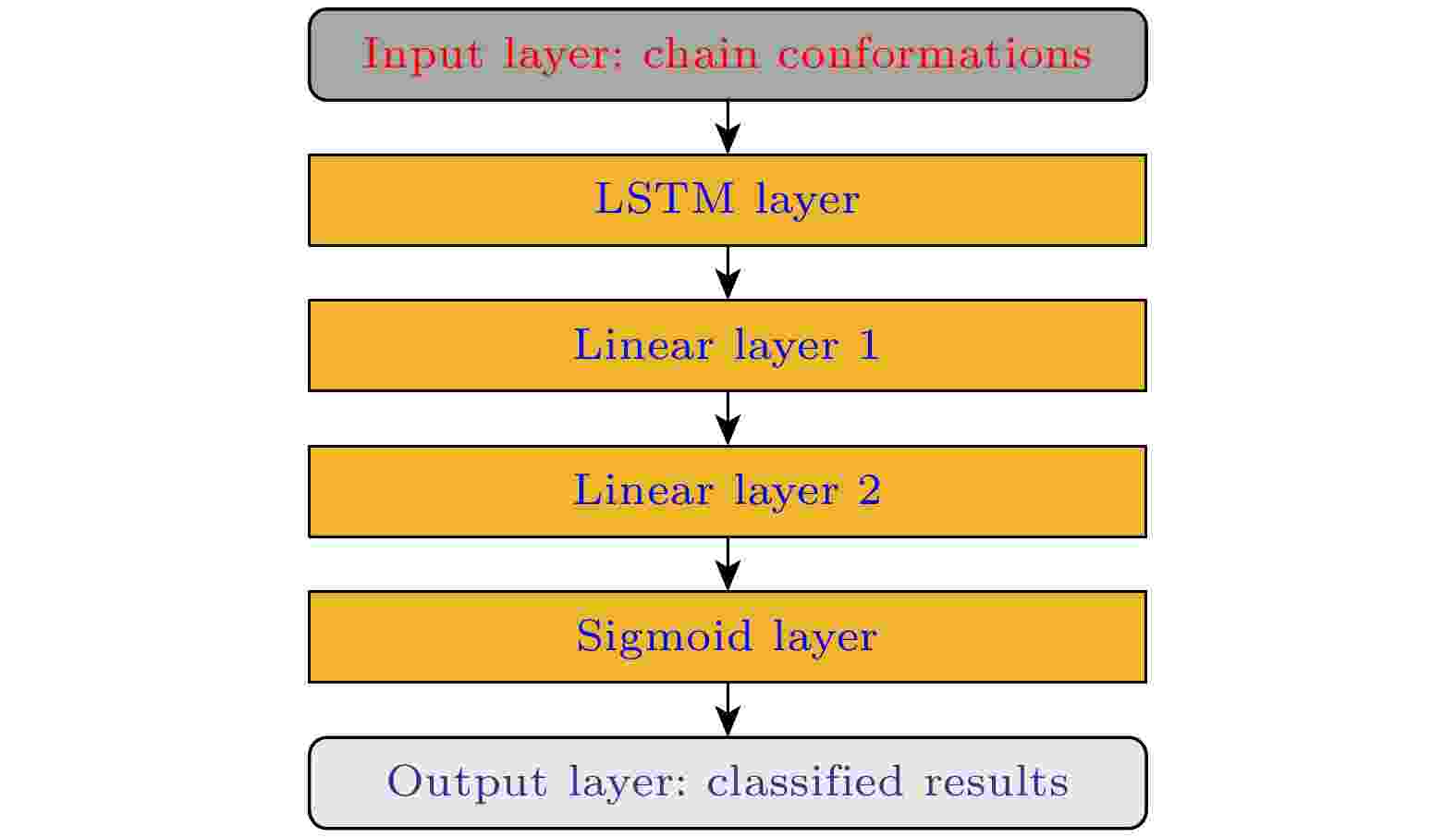
2023, 72 (24): 240502.
doi:10.7498/aps.72.20231058
Abstract +
Collapse and critical adsorption of polymers are two crucial phase transitions in polymer science, both are accompanied by significant changes in polymer conformation. In this paper, Langevin dynamics and dynamic Monte Carlo methods are used to simulate the collapse and critical adsorption of polymer, respectively, and corresponding phase transition temperatures are estimated. Meanwhile, a large number of polymer conformations at different temperatures are obtained. In the machine learning method, a large number of extended random coil and collapsed spherical, desorption and adsorption conformations are used to train the neural network, so that the neural network can learn the characteristics of different states of the polymer, and it can quickly and accurately analyze the polymer conformations at different temperatures and obtain the corresponding collapse phase transition temperature and critical adsorption temperature. The results demonstrate that machine learning can correctly calculate the phase transition temperature of polymer system, which provides new ideas and methods for machine learning technology in the study of polymer phase transitions.

2023, 72 (24): 248703.
doi:10.7498/aps.72.20231069
Abstract +
Modeling of RNA tertiary structure is one of the basic problems in molecular biophysics, and it is very important in understanding the biological function of RNA and designing new structures. RNA tertiary structure is mainly determined by seven torsions of main-chain and side-chain backbone, the accurate prediction of these torsion angles is the basis of modeling RNA tertiary structure. At present, there are only a few methods of using deep learning to predict RNA torsion angles, and the prediction accuracy needs further improving if it is used to model RNA tertiary structure. In this study, we also develop a deep learning method, 1dRNA, to predict RNA backbone torsions and pseudotorsion angles, including two different deep learning models, the convolution model (DRCNN) that considers the features of adjacent nucleotides and the Hyper-long-short-term memory model (DHLSTM) that considers the features of all the nucleotides. We then empirically show that DRCNN and DHLSTM outperform existing state-of-the-art methods under the same datasets, the prediction accuracy of DRCNN model is improved by 5% to 28% forβ,δ,ζ,χ,η, andθangle, and the prediction accuracy of DHLSTM model is improved by 6% to 15% forβ,δ,ζ,χ,η,θangle. The DRCNN model predicts better results than the DHLSTM model and the existing models in theδ,ζ,χ,η,θangle, and the DHLSTM model predicts better results than the DRCNN model and the existing model in theβandεangles, and the existing models predicted better results than the DRCNN model and DHLSTM model in theαandγangles. The DRCNN model and the existing models predict a richer distribution of angles than the DHLSTM model. In terms of model stability, the DHLSTM model is much more stable than the DRCNN model and the existing models, with fewer outliers. The results also show that theαangle andγangle are the most difficult to predict, the angles of the ring region is more difficult to predict than the angles of the helix region, the model is also not sensitive to the change of the target sequence length, and the deviation of the model prediction angle from the decoys can also be used to evaluate the RNA tertiary structures quality.
SPECIAL TOPIC—Machine learning in biomolecular simulations • COVER ARTICLE
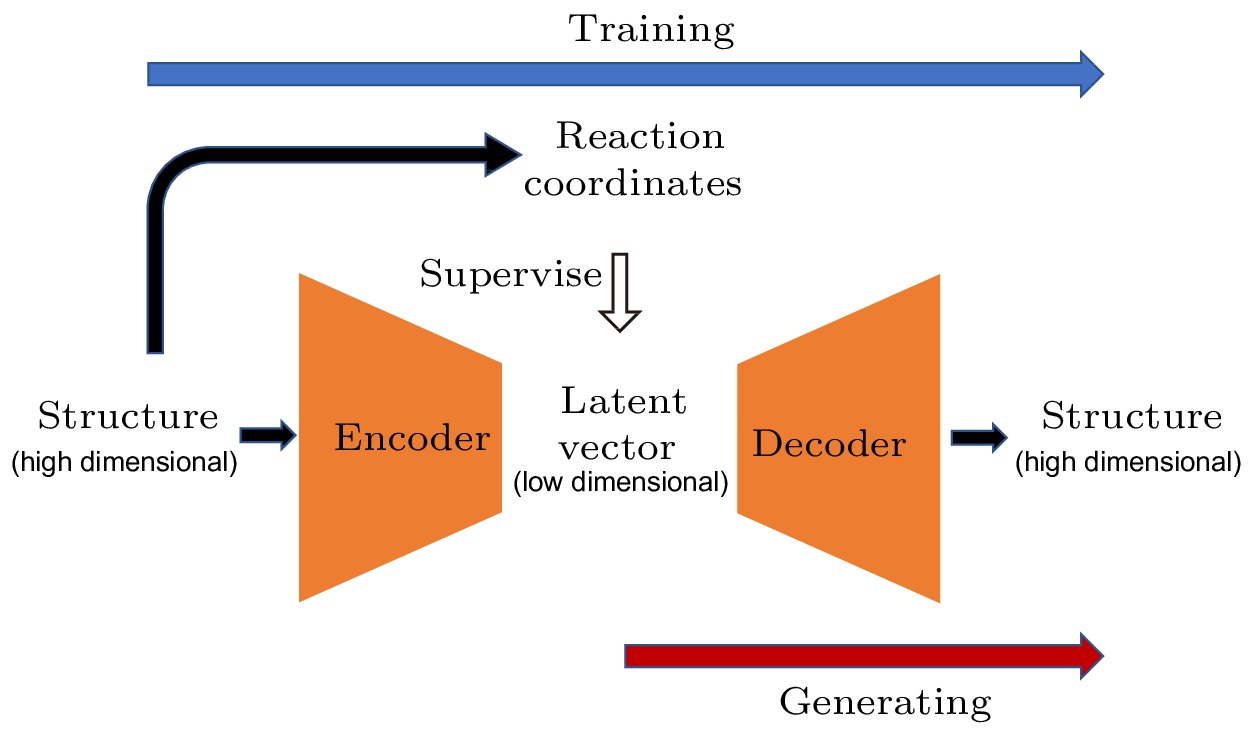
COVER ARTICLE
2023, 72 (24): 248705.
doi:10.7498/aps.72.20231060
Abstract +
Protein function is related to its structure and dynamic change. Molecular dynamics simulation is an important tool for studying protein dynamics by exploring its conformational space, however, conformational sampling is a nontrivial issue, because of the risk of missing key details during sampling. In recent years, deep learning methods, such as auto-encoder, can couple with MD to explore conformational space of protein. After being trained with the MD trajectories, auto-encoder can generate new conformations quickly by inputting random numbers in low dimension space. However, some problems still exist, such as requirements for the quality of the training set, the limitation of explorable area and the undefined sampling direction. In this work, we build a supervised auto-encoder, in which some reaction coordinates are used to guide conformational exploration along certain directions. We also try to expand the explorable area by training through the data generated by the model. Two multi-domain proteins, bacteriophage T4 lysozyme and adenylate kinase, are used to illustrate the method. In the case of the training set consisting of only under-sampled simulated trajectories, the supervised auto-encoder can still explore along the given reaction coordinates. The explored conformational space can cover all the experimental structures of the proteins and be extended to regions far from the training sets. Having been verified by molecular dynamics and secondary structure calculations, most of the conformations explored are found to be plausible. The supervised auto-encoder provides a way to efficiently expand the conformational space of a protein with limited computational resources, although some suitable reaction coordinates are required. By integrating appropriate reaction coordinates or experimental data, the supervised auto-encoder may serve as an efficient tool for exploring conformational space of proteins.
SPECIAL TOPIC—Two-dimensional magnetism and topological spin physics
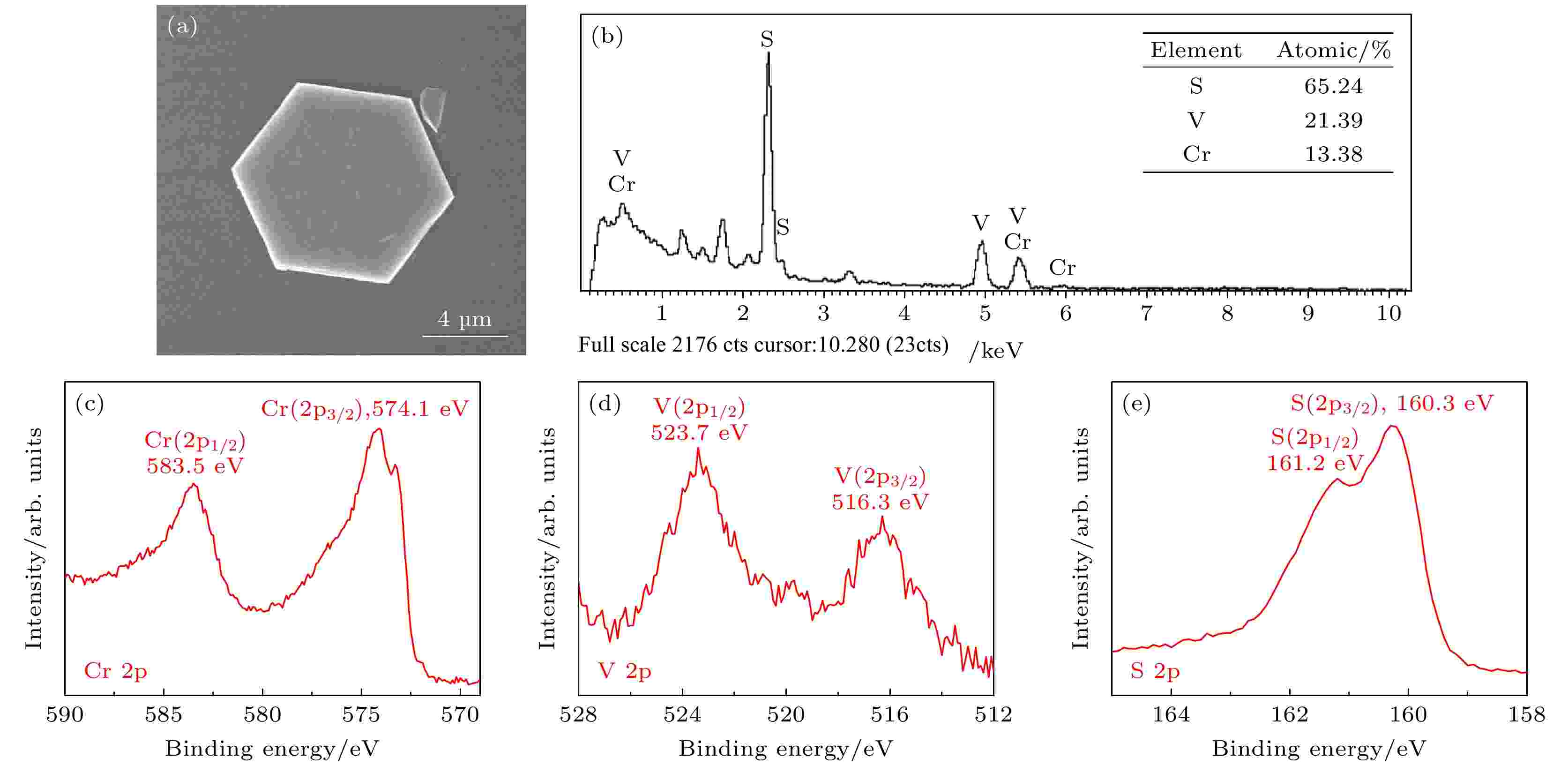
EDITOR'S SUGGESTION
2023, 72 (24): 247501.
doi:10.7498/aps.72.20231229
Abstract +
Two-dimensional magnetic materials are emerging materials developed in recent years and have attracted much attention for their unique magnetic properties and structural features in single-layer or few layers of atomic thickness. Among them, ferromagnetic materials have a wide range of applications such as in information memory and processing. Therefore the current research mainly focuses on enriching the two-dimensional ferromagnetic database and developing modification strategies for magnetic modulation. In this work, two-dimensional vanadium-doped Cr2S3nanosheets successfully grow on mica substrates by atmospheric pressure chemical vapour deposition. The thickness and size of the nanosheet can be effectively regulated by changing the temperature and mass of vanadium source VCl3powder, with the temperature of 765 ℃ and the mass of 0.010 g as the most appropriate conditions for the growth of nanosheets. The nanosheets are also characterised by optical microscopy, atomic force microscopy, Raman spectroscopy, scanning electron microscopy, X-ray energy spectroscopy, and X-ray photoelectron spectroscopy, and the nanosheet is regular in shape, with flat surface and controllable thickness, and the high-quality vanadium-doped Cr2S3nanosheet is prepared. Meanwhile, the magnetic characterisations of the doped samples show that the Curie transition temperatures of the vanadium doped samples change to 105 K, and the maximum magnetic moment point of 75 K in theM-Tcurve disappears after V doping, and from subferromagnetic material to ferromagnetic material, and the coercivity in theM-Hcurve also increases significantly, which proves that the vanadium doping can effectively regulate the magnetic properties of Cr2S3nanosheets. These results are expected to advance the vanadium-doped Cr2S3materials toward practical applications and become one of the ideal candidate materials for the next-generation spintronic applications.
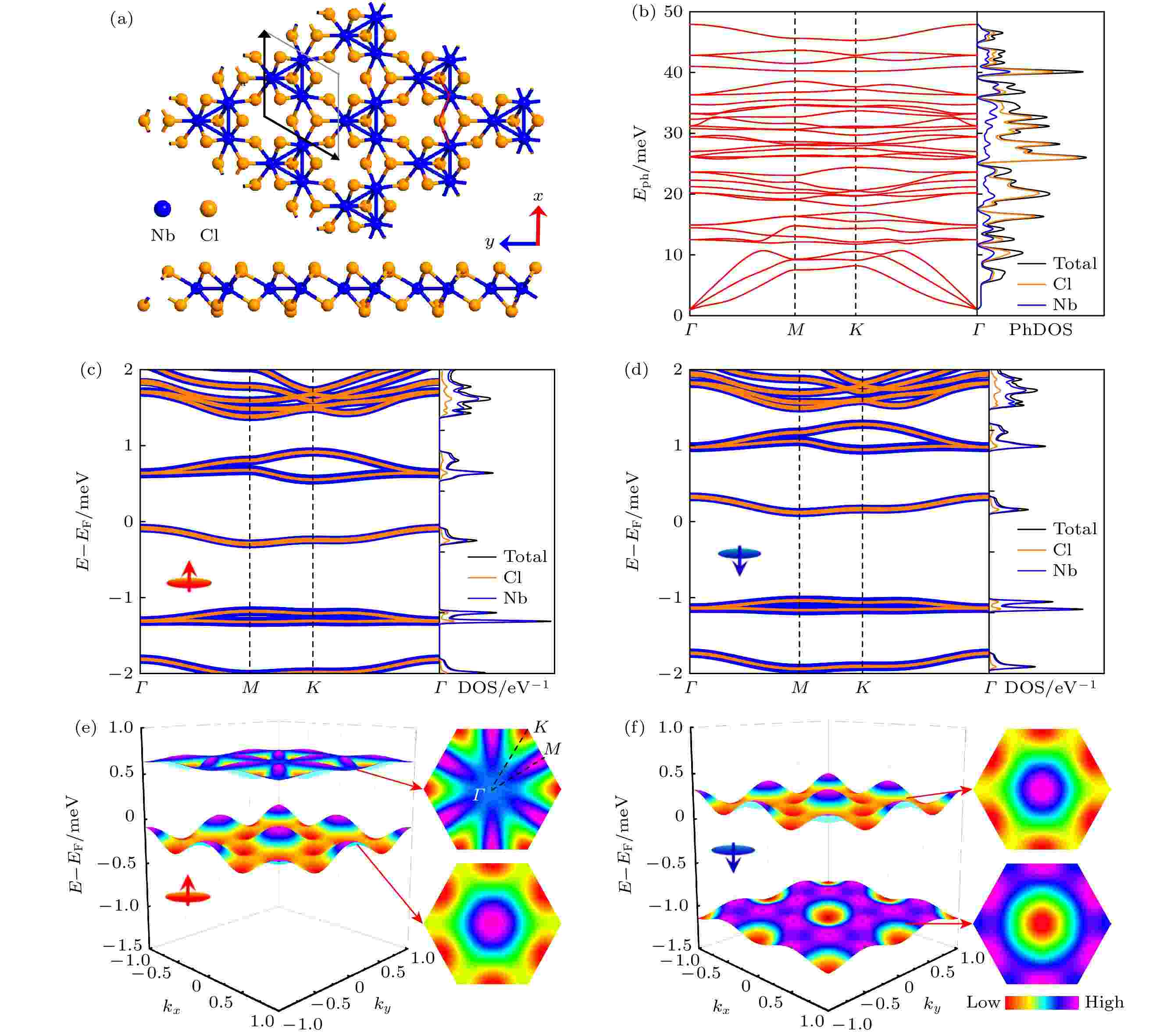
EDITOR'S SUGGESTION
2023, 72 (24): 247503.
doi:10.7498/aps.72.20231163
Abstract +
Two-dimensional semiconductor materials with intrinsic magnetism have great application prospects in realizing spintronic devices with low power consumption, small size and high efficiency. Some two-dimensional materials with special lattice structures, such as kagome lattice crystals, are favored by researchers because of their novel properties in magnetism and electronic properties. Recently, a new two-dimensional magnetic semiconductor material Nb3Cl8monolayer with kagome lattice structure was successfully prepared, which provides a new platform for exploring two-dimensional magnetic semiconductor devices with kagome structure. In this work, we study the electronic structure and magnetic anisotropy of Nb3Cl8monolayer. We also further construct its p-n junction diode and study its spin transport properties by using density functional theory combined with non-equilibrium Green’s function method. The results show that the phonon spectrum of the Nb3Cl8monolayer has no negative frequency, confirming its dynamic stability. The band gap of the spin-down state (1.157 eV) is significantly larger than that of the spin-up state (0.639 eV). The magnetic moment of the Nb3Cl8monolayer is 0.997 μB, and its easy magnetization axis is in the plane and along thex-axis direction based on its energy of magnetic anisotropy. The Nb atoms make the main contribution to the magnetic anisotropy. When the strain is applied, the band gap of the spin-down states will decrease, while the band gap of the spin-up state monotonically decreases from the negative (compress) to positive (tensile) strain. As the strain variable goes from –6% to 6%, the contribution of Nb atoms to the total magnetic moment gradually increases. Moreover, strain causes the easy magnetization axis of the Nb3Cl8monolayer to flip vertically from in-plane to out-plane. The designed p-n junction diode nanodevice based on Nb3Cl8monolayer exhibits an obvious rectification effect. In addition, the current in the spin-up state is larger than that in the spin-down state, exhibiting a spin-polarized transport behavior. Moreover, a negative differential resistance (NDR) phenomenon is also observed, which could be used in the NDR devices. These results demonstrate that the Nb3Cl8monolayer material has great potential applications in the next-generation high-performance spintronic devices, and further experimental verification and exploration of this material and related two-dimensional materials are needed.
GENERAL
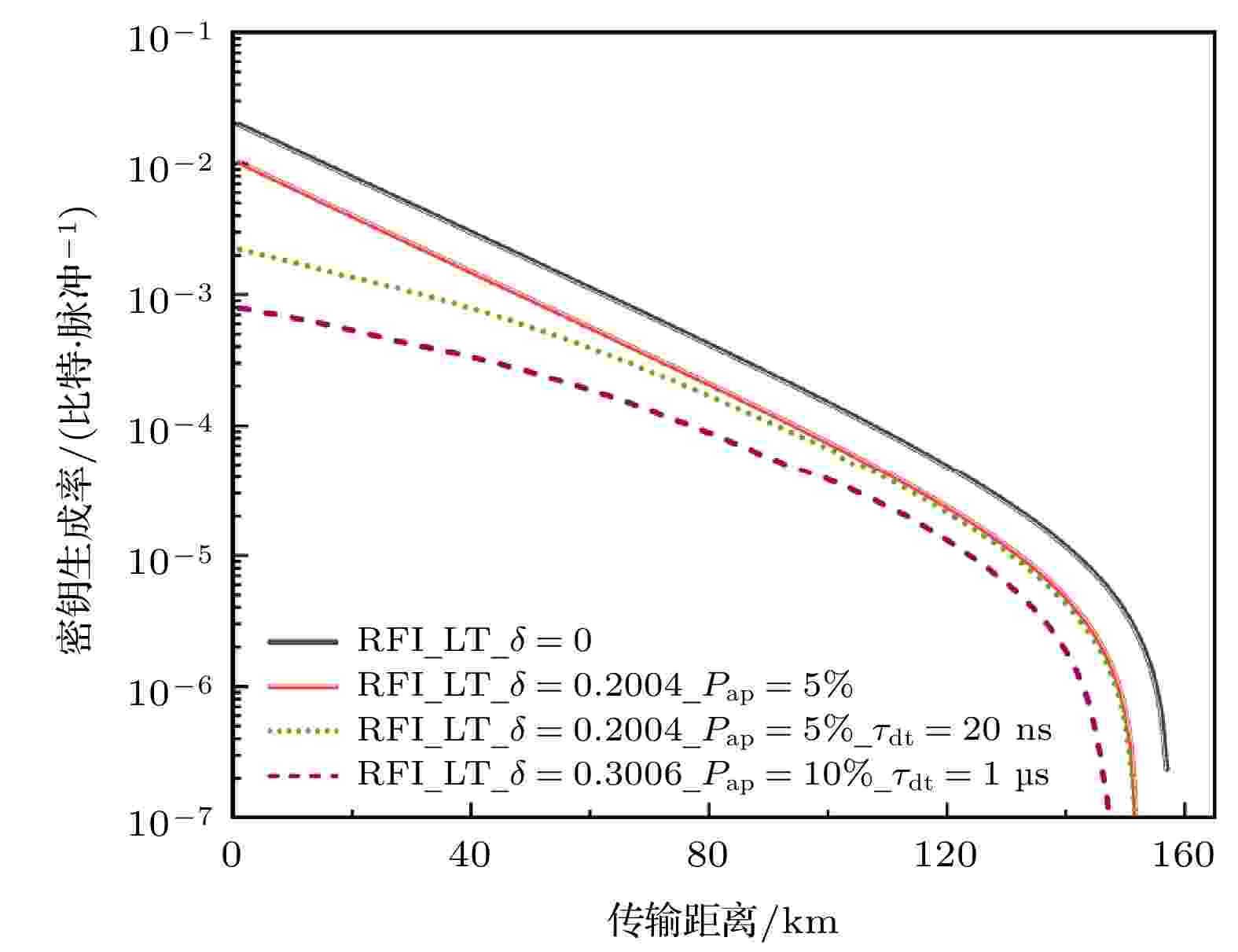
EDITOR'S SUGGESTION
2023, 72 (24): 240301.
doi:10.7498/aps.72.20231144
Abstract +
Quantum key distribution (QKD) enables the establishment of shared keys between two distant users, Alice and Bob, based on the fundamental principles of quantum mechanics, and it has proven to possess information-theoretic security. In most of QKD systems, Alice and Bob require a shared reference frame, and real-time calibration of the reference frame increases system costs and reduces its performance. Fortunately, the reference-frame-independent QKD protocol has been proposed, overcoming reference-frame drift issues and receiving widespread attention. However, in practical QKD systems, the non-ideal characteristics of realistic devices introduce certain inconsistency between the theory and the practice. In real-world quantum key distribution systems, device imperfections can lead to security vulnerabilities, thereby reducing system security. For example, imperfections in the encoding apparatus at the source end may result in errors in the quantum states. The inherent defects in the detection part may cause after-pulse effects and dead-time effects, thus reducing the key rate. Therefore, in this work, we propose a practical state-preparation error tolerant reference-frame-independent quantum key distribution protocol by taking imperfections in both the source and the detectors into account. Moreover, a three-intensity decoy-state scheme for modeling analysis and numerical simulations is employed. In this protocol, we reduce the influence of state-preparation errors on the key rate by utilizing virtual state methods to precisely estimate the phase-error rate. Furthermore, by characterizing the effects of after-pulses and dead-time on the key rate, our protocol exhibits higher robustness and can effectively address issues related to detector imperfections. This approach can also be extended to other quantum key distribution protocols with higher security levels, such as measurement-device-independent quantum key distribution protocol and twin-field quantum key distribution, further mitigating the influence of device imperfections on practical implementation of QKD system. Therefore, our present work provide important reference value for putting the quantum key distributions into practical application.

EDITOR'S SUGGESTION
2023, 72 (24): 240601.
doi:10.7498/aps.72.20231292
Abstract +
The DASH (Doppler asymmetric spatial heterodyne) is used to detect the upper atmospheric wind speed by its imaging Fizeau interference fringes. There are two wind measurement methods: Fourier series method (FSM) and popular Fourier transform method (FTM). However, the wind speed measurement accuracy of FTM is greatly influenced by window function, and the calculation is relatively complicated. The Four-point algorithm (FPA) for DASH’s wind speed measurement is proposed in this paper. The contents of wind speed measurement principle, forward modeling, noise and inversion by the FSM, FTM and FPA are wholly compared and studied. The three wind speed measurement methods are all derived from the phase difference transformation of DASH Fizeau interference fringes. The Fizeau interference fringes with wind speed of 0–100 m/s at the interval of 10 m/s are simulated, and the forward wind speeds are obtained by FSM, FTM and FPA, and the corresponding wind measurement errors are 2.93%, 4.67% and 3.00%, respectively. After artificially adding Gaussian noise with a mean value of 0 and a standard deviation of 0.1, FSM, FTM and FPA are used to forward the Fizeau interference fringes after flat field, and the corresponding relative errors are 2.30%, 11.66% and 2.27%, respectively. After artificially adding Gaussian noise, the Fizeau interference fringes of wind speeds of 31–39 m/s with 1 m/s interval and 30.1–30.9 m/s with 0.1 m/s interval are simulated, and the forward wind speeds are obtained by FSM and FPA. In both cases, the wind speed measurement errors of FSM are 3.55% and 4.15% higher than those of FPA. The O(1S) 557.7 nm airglow at peak altitude of 98 km in Xi’an was photographed by using our GBAII (ground based airglow imaging interferometer)-DASH, and the imaging interferograms with zenith angles of 0° and 45° were obtained. Then by the methods of Fourier series, Fourier transform and FPA are used to obtain the inversion wind speed of 32.21 m/s, 43.55 m/s and 32.17 m/s, respectively. From the forward and inversion results of DASH, we can see that the FPA has a better result for detecting the upper atmospheric wind due to its simple calculation and smaller wind measurement error.
ATOMIC AND MOLECULAR PHYSICS
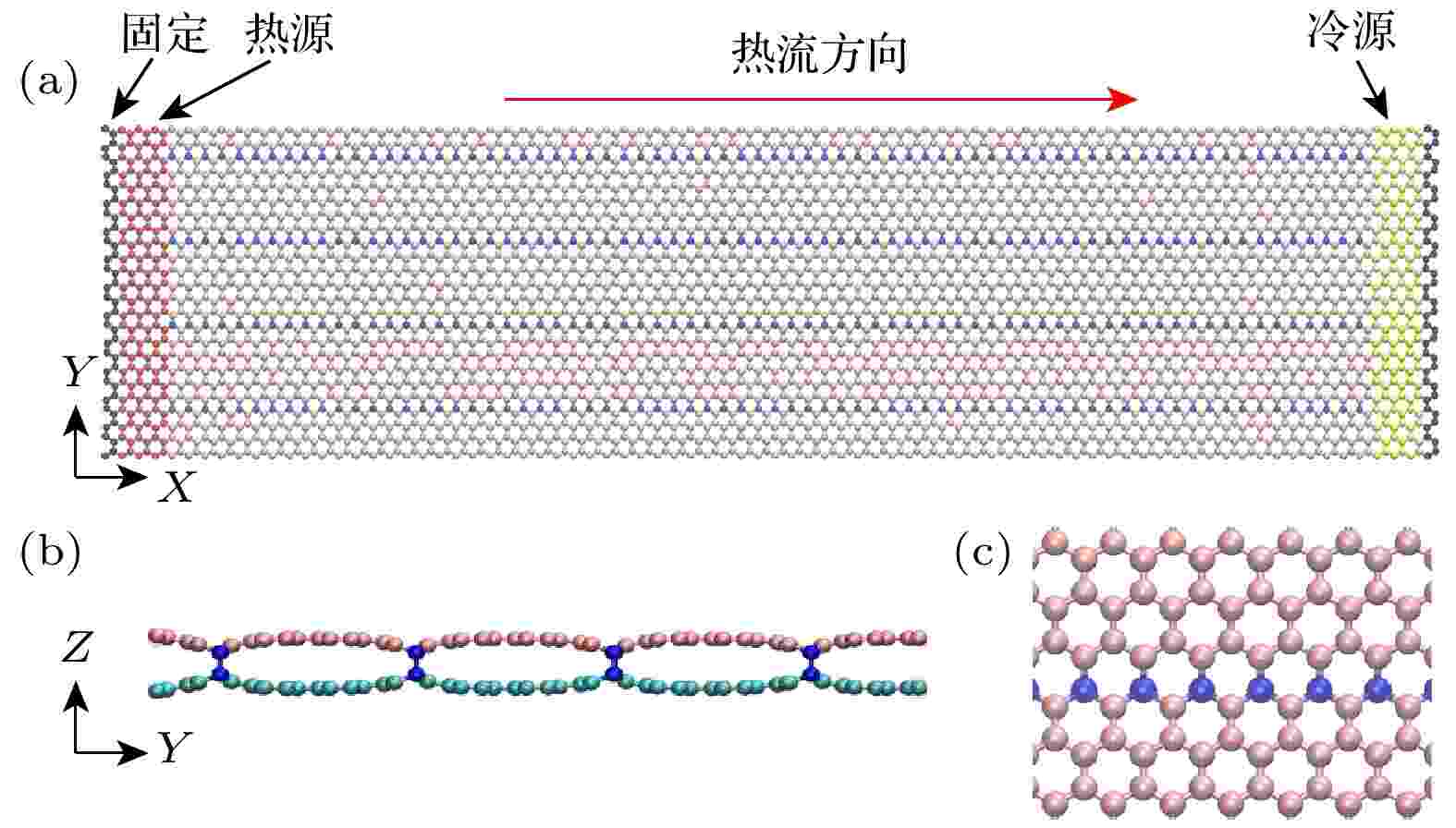
2023, 72 (24): 243101.
doi:10.7498/aps.72.20231230
Abstract +
The interlayer bonding of graphene is a method of modifying graphene, which can change the mechanical property and conductivity of graphene, but also affect its thermal properties. In this paper, the non-equilibrium molecular dynamics method is used to study the thermal conductivity of bilayer graphene nanoribbon which is local carbon sp3hybridization (covalent bond formed between layers) under different concentration and angle of interlayer covalent bond chain and different tensile strain. The mechanism of the change of the thermal conductivity of bilayer graphene nanoribbon is analyzed through the density of phonon states. The results are as follows. The thermal conductivity of bilayer graphene nanoribbon decreases with the increase of the interlayer covalent bond concentration due to the intensification of phonon scattering and the reduction of phonon group velocities and effective phonon mean free path. Moreover, the decrease rate of thermal conductivity depends on the distribution angle of covalent bond chain. With the increase of interlayer covalent bond concentration, when the interlayer covalent bond chain is parallel to the direction of heat flow, the thermal conductivity decreases slowest because the heat transfer channel along the heat flow direction is gradually affected; when the interlayer covalent bond chain is at an angle with respect to the direction of heat flow, the thermal conductivity decreases more rapidly, and the larger the angle, the faster the thermal conductivity decreases. The rapid decline of thermal conductivity is due to the formation of interfacial thermal resistance at the interlayer covalent bond chain, where strong phonon-interface scattering occurs. In addition, it is found that the thermal conductivity of bilayer graphene nanoribbon with interlayer bonding will be further reduced by tensile strain due to the intensification of phonon scattering and the reduction of phonon group velocity. The results show that the thermal conductivity of bilayer graphene nanoribbon can be controlled by interlayer bonding and tensile strain. These conclusions are of great significance in designing and thermally controlling of graphene based nanodevices.
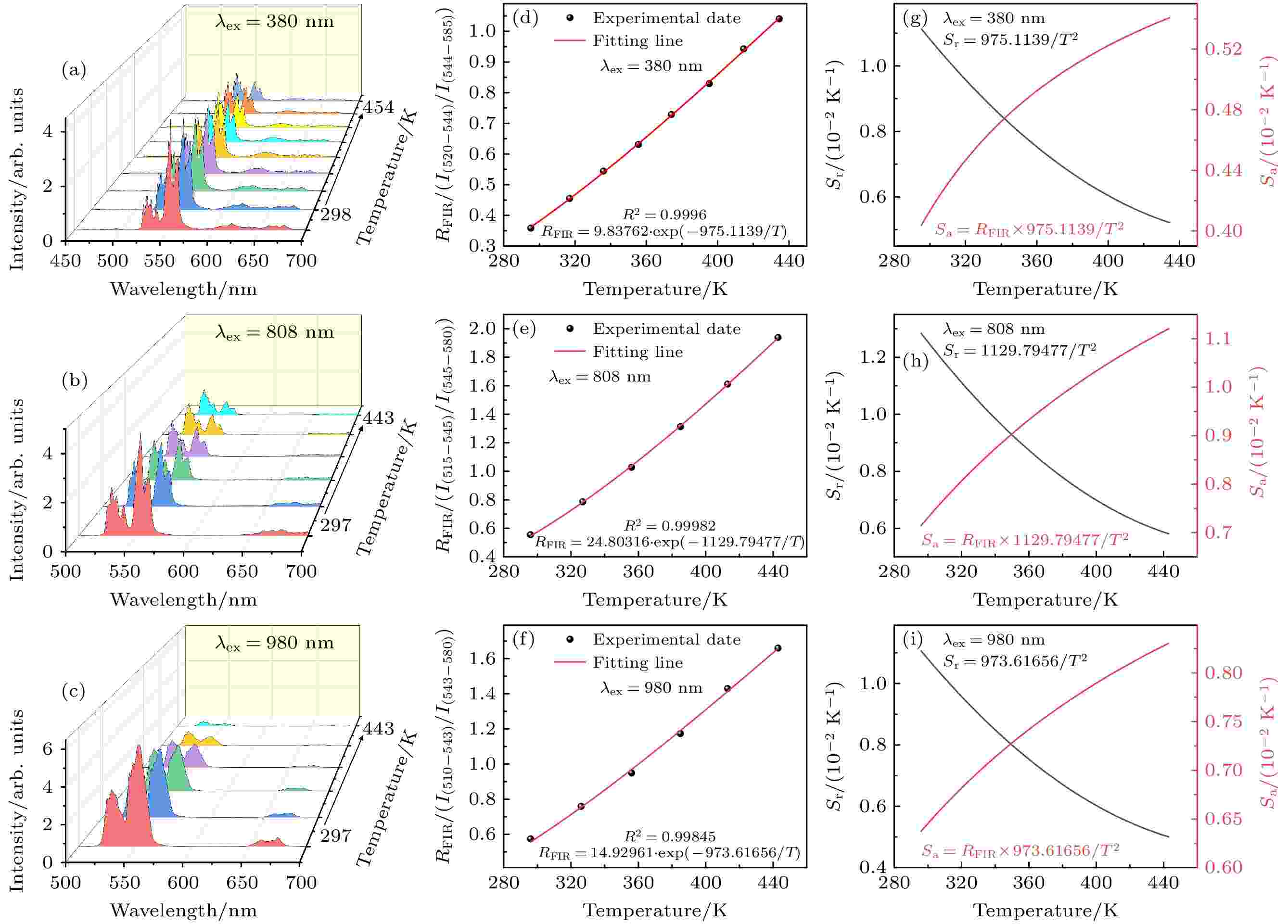
2023, 72 (24): 243301.
doi:10.7498/aps.72.20231170
Abstract +
Photothermal sensing is crucial in developing smart wearable devices. However, designing and synthesizing luminescent materials with suitable multi-wavelength emission and constructing multiple sets of probes in a single material system is a huge challenge for constructing sensitive temperature sensors with a wide temperature range. In this paper, Pr3+, Er3+single-doped and double-doped Li0.9K0.1NbO3phosphors are successfully prepared by high temperature solid phase method, and their structures, morphologies, excitation wavelengths and temperature-dependent fluorescence properties are characterized by XRD, SEM, fluorescence spectrometer and self-made heating device. Firstly, the photoluminescences of the synthesized series of samples are investigated. The results show that comparing with the single-doped Li0.9K0.1NbO3: Er3+sample, the up/down-conversion spectra of Pr3+, Er3+co-doped phosphors under 808 nm/380 nm excitation show that the green fluorescence emission of Er3+is enhanced. In addition, under 980 nm excitation, Pr3+can effectively regulate the fluorescence energy level population pathway, so that the electrons are more effectively arranged in the2H11/2and4S3/2energy levels in the excitation process. The red emission is weakened and the green emission is enhanced, which improves the signal resolution of the fluorescent material and has a significant influence on the optical temperature measurement. Secondly, the up-conversion fluorescence property of Er3+under 808 nm/980 nm laser excitation in Li0.9K0.1NbO3:Er3+and Li0.9K0.1NbO3:Pr3+,Er3+phosphors are investigated. The results show that the red and green fluorescence emissions of Er3+are two-photon processes. Finally, the up/down-conversion dual-mode temperature sensing properties of Er3+in Li0.9K0.1NbO3:Er3+and Li0.9K0.1NbO3:Pr3+, Er3+phosphors are investigated. It is found that both materials have good optical temperature measurement performances. The Pr3+doping optimizes the dual-mode optical temperature measurement performances of Li0.9K0.1NbO3:Er3+phosphors derived from the thermal coupling energy level of Er3+ions. In addition, the up/down-conversion fluorescence mechanism of Li0.9K0.1NbO3:Er3+and Li0.9K0.1NbO3:Er3+, Pr3+phosphors are proposed, and the enhanced green fluorescence by Pr3+co-doping is attributed to the energy transfer from Pr3+ions to Er3+ions, leading to the increase of green fluorescence level population and the decrease of red fluorescence level population of the Er3+ions. This new dual-mode optical temperature measurement material provides a material basis and optical temperature measurement technology for exploring other temperature measurement materials.
ELECTROMAGNETISM, OPTICS, ACOUSTICS, HEAT TRANSFER, CLASSICAL MECHANICS, AND FLUID DYNAMICS
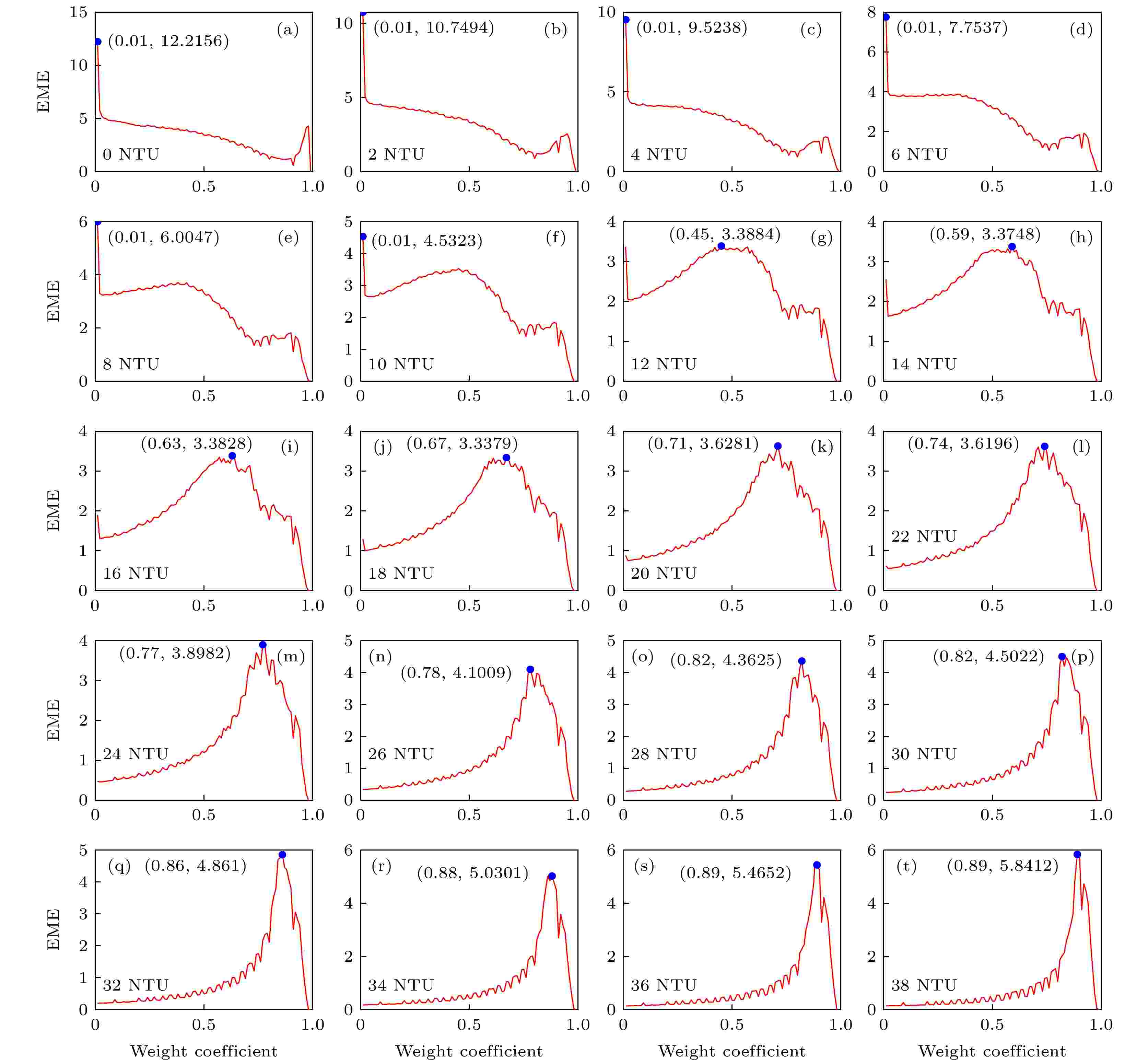
2023, 72 (24): 244201.
doi:10.7498/aps.72.20230639
Abstract +
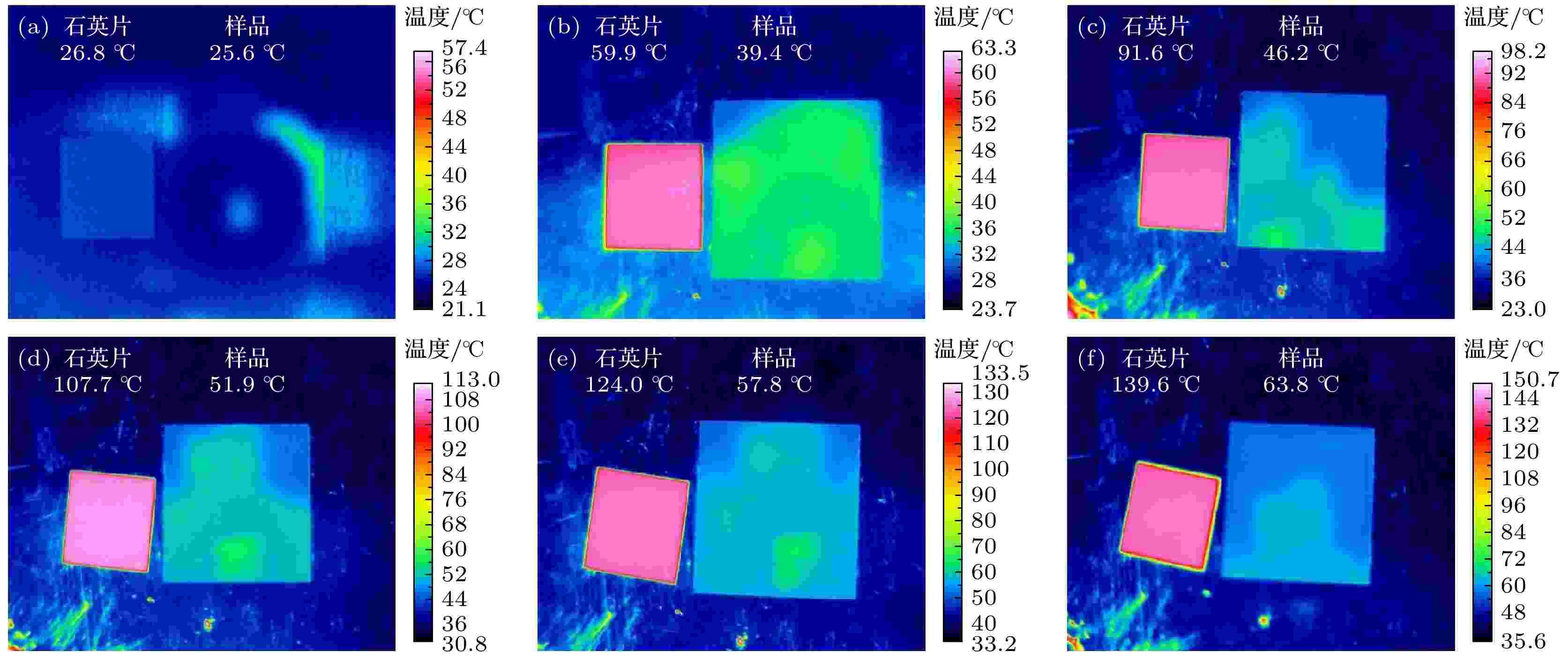
2023, 72 (24): 244202.
doi:10.7498/aps.72.20231084
Abstract +
Multi-spectral compatible stealth materials have become an imperative development trend, especially visible and infrared compatible stealth materials have become the most important in the field of optoelectronic stealth technology. However, infrared stealth and visible stealth have different requirements for spectral response, which makes it difficult to reconcile the design of functional coupling materials. Therefore, it is very important to develop selective control technology of optical characteristics. A visible and infrared compatible stealth superstructure thin film is proposed based on the FTO/Ag/FTO stacked film structure. A collaborative design method for high visible transmission and low infrared radiation is established, and the mechanism of microstructure characteristics affecting visible transmission and infrared reflection spectra is explained. The infrared stealth thin film with high transparency is optimized, and its compatibility stealth performance is tested and characterized by visible light transmission spectrum, infrared reflection spectrum, and thermal imaging characterization technology. It is shown that visible transmission depends on the coupling and matching effect between the semiconductor dielectric layer and the metal layer, while infrared radiation suppression mainly relies on the metal layer. As the thickness of FTO film increases, the visible transmission peak undergoes a red shift, leading the transmission spectrum curve to flatten, the average transmission first increases and then gradually decreases. As the thickness of Ag thin film layer increases, the transmission peak of visible light undergoes a blue shift, causing the transmission spectrum curve to tend to a high-frequency transmission state, narrowing the frequency domain of visible light transmission and gradually reducing the average transmittance decreases gradually. At the same time, the infrared reflectance increases with the Ag film thickness increasing, but the change of amplitude significantly decreasing when the Ag film thickness is greater than 18 nm. When the thickness of the optimized FTO/Ag/FTO film structure is 40/12/40 nm, it has a high level of background perspective reproduction and high ability to suppress high-temperature infrared radiation. The average transmittance of 0.38–0.78 μm visible light band is 82.52%, and the average reflectance of 3–14 μm mid-far infrared band is 81.46%. The radiation temperature of the sample is 49 ℃ lower in the mid infrared range and 75.8 ℃ lower in far infrared range than that of the quartz sheet at 150 ℃, respectively. The new stealth film can be attached to the camouflage coating surface of special vehicle to achieve visible and infrared compatible stealth, and can be used for cockpit windows to ensure thermal insulation, temperature control, and infrared stealth without affecting the field of view. This study can provide a new approach for designing and utilizing the visible and infrared compatible stealth materials.
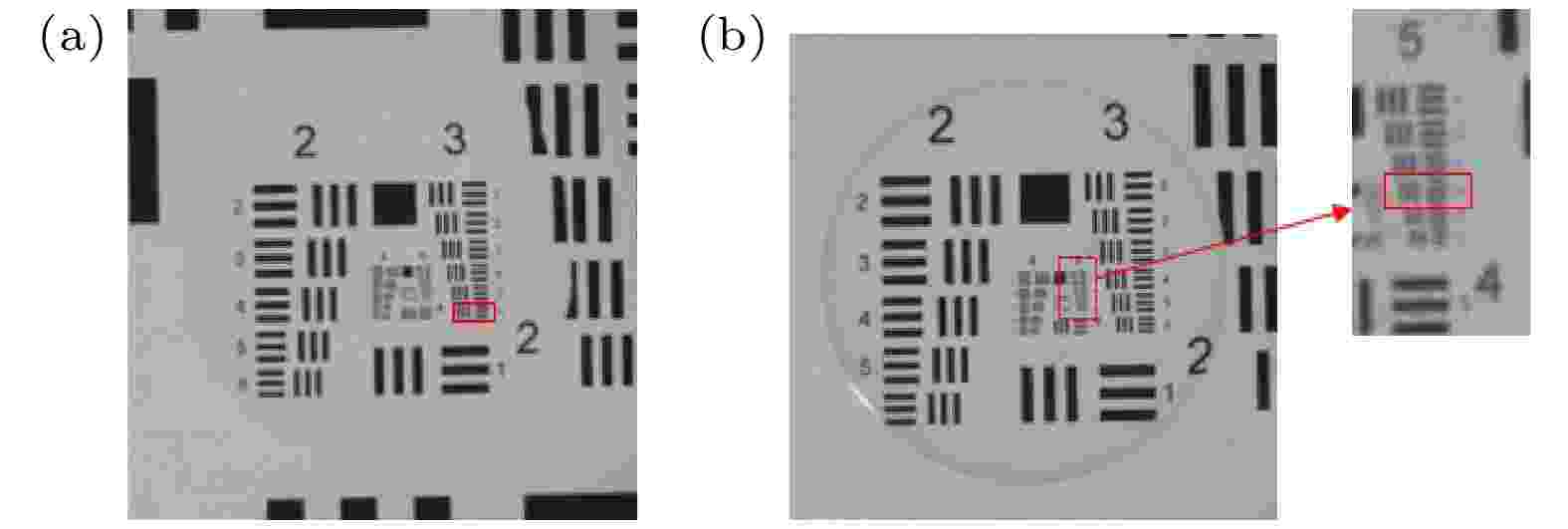
2023, 72 (24): 244203.
doi:10.7498/aps.72.20230994
Abstract +
According to the principle of dielectrophoresis, an aspherical double-liquid lens based on parallel plate electrodes is designed. In comparison with the liquid lenses based on patterned-electrodes, the aspherical double-liquid lens structure uses continuous electrodes, which have the advantages of simpler processing, lower cost, easier realization and more practicability. The droplet in the dielectric electrophoretic liquid lens is polarized in the electric field and moves towards the higher electric field intensity under the action of the dielectrophoretic force. With the change of applied voltage, the dielectrophoretic force varies, thus the contact angle of the droplet at the liquid-liquid interface is changed. Firstly, the models of aspherical double-liquid lenses under different voltages are established with Comsol software, and the data of interfacial profile are derived. Then using Matlab software, the derived interface surface data are fitted by polynomial, and the aspherical coefficients are obtained. Finally, the optical models are built with Zemax software, and the variation range of focal length and root mean square (RMS) radius of aspherical double-liquid lens under different voltages are analyzed. In order to further study the characteristics of aspherical double-liquid lens, it is compared with spherical double-liquid lens model. The liquid material, cavity structure and droplet volume of spherical double-liquid lens are consistent with those of aspherical double-liquid lens. The corresponding spherical double-liquid lens model is established by using the Zemax software, the range of focal length and RMS radius of spherical double-liquid lens under different voltages are obtained. The results show that the focal length variation range of aspherical double-liquid lens is larger than that of spherical double-liquid lens, and the imaging quality of the former is better than that of the latter. The experimental preparation of the designed aspherical double-liquid lens device is carried out, and its focal length and imaging resolution are measured. When the operating voltage is in a range of 0–280 V, the focal length varies from 54.2391 to 34.5855 mm, which is basically consistent with the simulation result. The feasibility of the liquid lens structure is verified experimentally. The imaging resolution can reach 45.255 lp/mm. The designed aspherical double-liquid lens based on the parallel plate electrode can provide a new scheme for the high-quality imaging of liquid lens and its application, and can expand the application scope of liquid lens.

2023, 72 (24): 244204.
doi:10.7498/aps.72.20231321
Abstract +
In this work, a one-dimensional lattice theory scheme is proposed based on superconducting microwave cavity, which includes two different types of microwave cavity unit cells. The coupling between the unit cells is controlled by flux qubits to simulate and study their topological insulator characteristics. Specifically, by mapping the counter-rotating wave terms into the p-wave superconducting pairing term, a one-dimensional superconducting microwave cavity lattice scheme with a p-wave superconducting pairing term is obtained. It is found that the p-wave superconducting pairing term can modulate the topological quantum state of the system, allowing the topological quantum information transmission channels with four edge states to be created. In addition, when the p-wave superconducting pairing term interacts with the nearest-neighbor, the energy band undergoes fluctuations, thus inducing new energy bands to be generated, but the degeneracy of the edge states remains stable, which can realize the multiple topological quantum state transmission paths. However, when its regulation exceeds the threshold, the energy gap of the system will close, causing the edge states to annihilate in a new energy band. Furthermore, with defects considered to exist in the system, when the strength of the defect is small, the edge state produces small fluctuations, but it can be clearly distinguished, showing its robustness. When the strength of the defect exceeds the threshold, the edge state and energy band will cause irregular fluctuations, allowing the edge state to integrate into an energy band. Our research results have important theoretical value and practical significance, and can be applied to quantum optics and quantum information processing in the future.
PHYSICS OF GASES, PLASMAS, AND ELECTRIC DISCHARGES
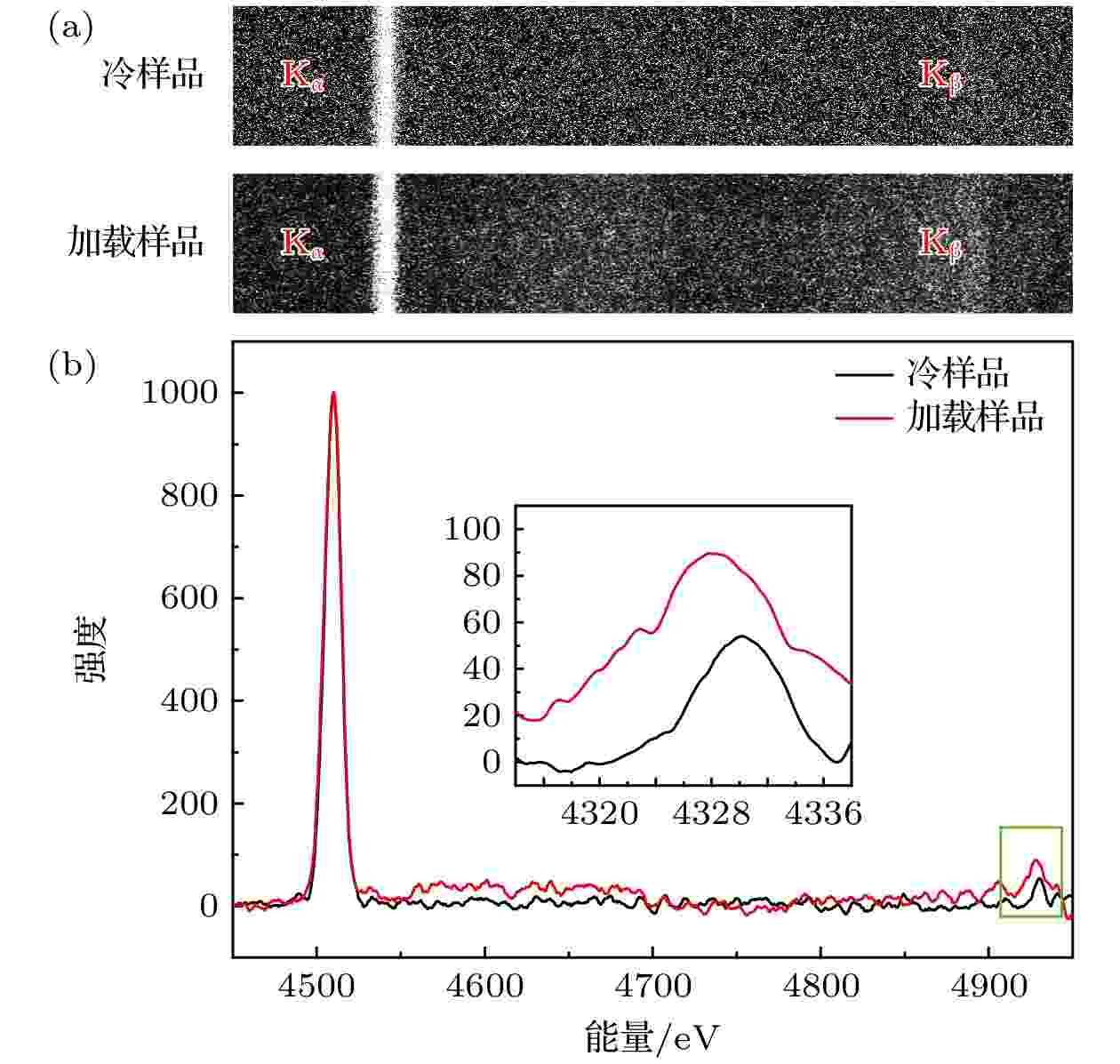
Density effect on electronic structure of warm dense matter based on X-ray fluorescence spectroscopy
2023, 72 (24): 245201.
doi:10.7498/aps.72.20231215
Abstract +
Warm dense matter (WDM), a kind of transition state of matter between cold condensed matter and high temperature plasma, is one of the main research objects of high energy density physics (HEDP). Compared with the structure of isolated atom, the electron structure of WDM will change significantly because of the influences of density and temperature effect. As WDM is always strongly coupled and partly degenerate, accurate theoretical description is very complicated and the accurate experimental research is also very challenging. In this paper, the density effect on the warm dense matter electron structure based on the X-ray fluorescence spectroscopy is studied. The warm dense titanium with density larger than solid density is produced experimentally based on a specially designed hohlraum. Then, the titanium is pumped to emit fluorescence by using the characteristic line spectrum emitted by the laser irradiating the pump material (Vanadium). The X-ray fluorescence spectra of titanium with different states are diagnosed by changing the delay time between the pump laser and drive laser. The experimental fluorescence spectrum indicates that the difference in energy between
${\mathrm{K}}_{\text{β}} $
and
$ {\mathrm{K}}_{\text{α}} $
(
$\Delta E_{{\mathrm{K}}_{\text{β}}\text{-}{\mathrm{K}}_{\text{α}}}$
) of the compressed titanium (7.2–9.2 g/cm3, 1.6–2.4 eV) is about 2 eV smaller than that of cold titanium. Two theoretical methods, i.e. finite-temperature relativistic density functional theory (FTRDFT) and two-step Hartree-Fock-Slater (TSHFS), are used to calculate the fluorescence spectrum of warm dense titanium. The calculated results indicate that the energy difference (
$\Delta E_{{\mathrm{K}}_{\text{β}}\text{-}{\mathrm{K}}_{\text{α}}} $
) decreases with the increase of density but changes slowly with the increase of temperature during the calculated state (4.5–13.5 g/cm3, 0.03–5 eV). The FTRDFT overestimates the density effect on the line shift, while TSHFS underestimates the density effect. The future work will focus on optimizing the experimental method of X-ray fluorescence spectroscopy, obtaining X-ray fluorescence spectrum of titanium with more states, and then testing the theoretical method for warm dense matter.
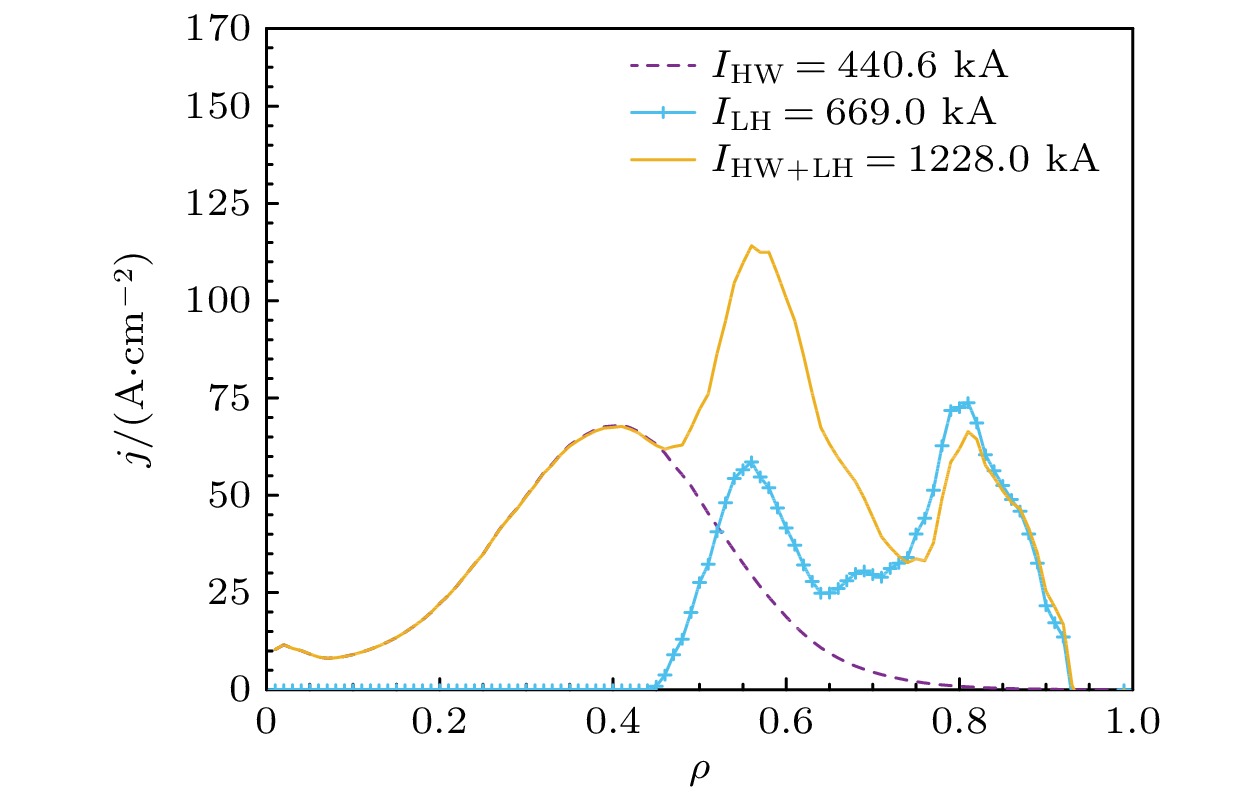
2023, 72 (24): 245202.
doi:10.7498/aps.72.20231077
Abstract +
Non-inductive current drive plays a crucial role in tokamak, especially for its steady state operations. Recently, the helicon wave (HW) has been regarded as a promising tool for driving off-axis plasma current in reactor-grade machine. The lower-hybrid wave (LHW) is the most effective radio-frequency current drive method, however, it has the drawback, which is limited by the conditions of wave accessibility in the high parameter tokamak, making the wave power usually damped at the plasma edge. HW can spiral towards the plasma centre directly under a high electron density. To obtain a long pulse steady state operation of reactor tokamak, the complementarity of HW and LHW in the aspect of driven current distribution in the high parameter tokamak is considered. The synergy current drive of the HW and the LHW is studied numerically in the steady-state scenario of HL-2M. According to the fast wave dispersion relation of plasma, the HW parameters, including its wave frequency and launched parallel refractive index, are obtained firstly. Results of GENRAY code simulation show that a single pass wave power absorption of the HW can be obtained generally through the electron Landau damping and transit time magnetic pumping effects. On the other hand, the LHW parameters are adopted from the equipped system on the machine. Results of single pass wave absorption are also obtained in the case of LHW. And then, the synergy effects of HW and LHW are studied numerically based on the GENRAY/CQL3D models. The cooperation of these two waves results in a broad plasma current distribution along the radial direction (
$\rho = $
0.2-0.9) in the machine. Taking the electron distribution functions of these waves into account, it is clear that the electrons are accelerated by the HW in the parallel magnetic field direction, resulting in more electrons entering the region of LHW resonance area. As the consequence, a net plasma current appears. Furthermore, a fine-grained parametric scan is performed by changing the launched parallel refractive index of HW, and the results indicate that positive synergy effects can be generally observed once the related wave current drive profiles are overlapped. Finally, the synergy factor is shown to be proportional to this overlap and reaches its maximum value of 1.18 in HL-2M.
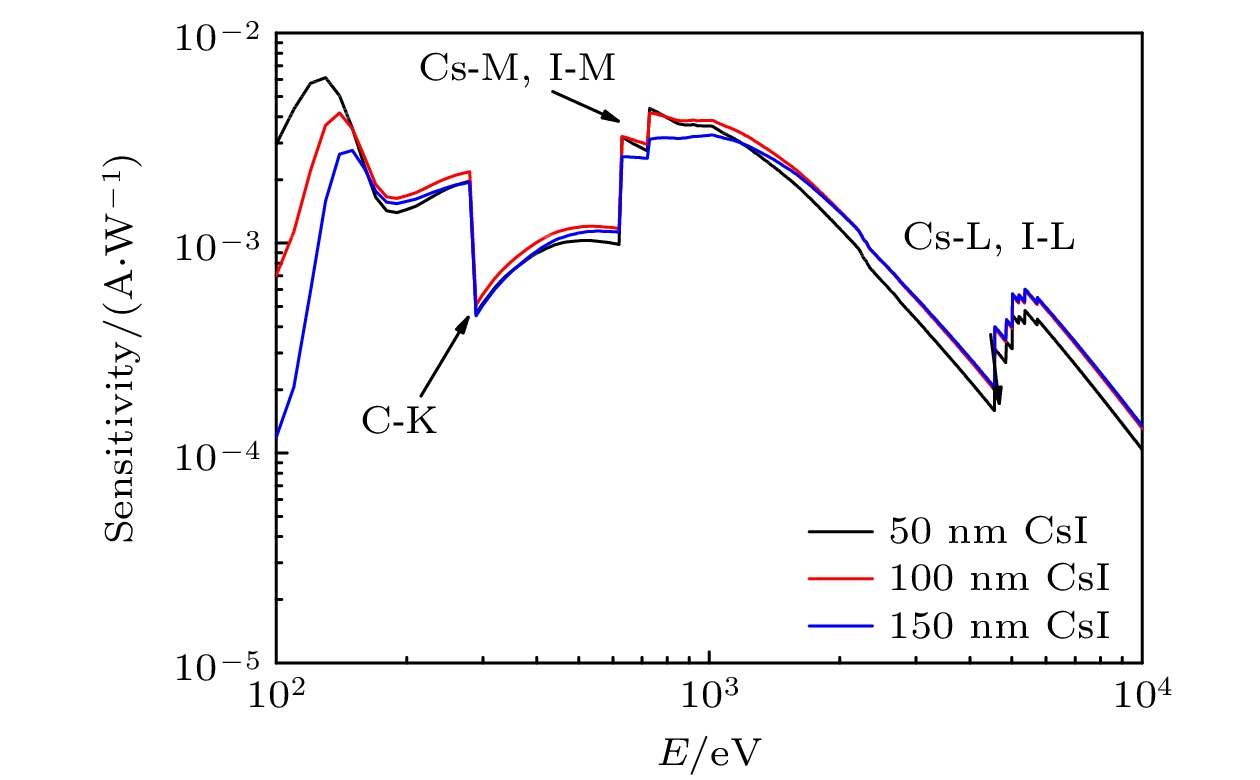
2023, 72 (24): 245203.
doi:10.7498/aps.72.20231043
Abstract +
The response sensitivity of CsI photocathode is an important parameter for the quantitative diagnosis of X-ray spectroscopy by soft X-ray streak camera, and its theoretical calculation has important guiding significance. The current theoretical analytical models are based on the one-dimensional random walking model of secondary electrons generated by thin film photocathodes, including the Henke model under the condition of normal incidence of X-rays and energy greater than 1 keV, and the Fraser model under variable angle incidence and photocathode thickness greater than 100 nm, which have certain limitations. In this paper, the basic expression of the probability of secondary electron transmission is introduced, and the general expression of the response sensitivity of CsI photocathode is deduced, which varies with X-ray energyE, photocathode thicknesst, and angleθbetween X-ray and cathode surface in a larger parameter range (X-ray energy 0.1–10 keV, photocathode thickness 10–200 nm). Finally, the theoretical calculation results of this paper are discussed by comparing it with those from the Henke model, Fraser model, literature data and experimental data on Beijing synchrotron radiation facility, which verifies the accuracy and universality of the computational model, and a theoretical reference is provided for optimally designing the CsI photocathode in high-time-resolution spectrometric quantitative measurement.

2023, 72 (24): 245204.
doi:10.7498/aps.72.20230651
Abstract +
In the fusion irradiation environment, dislocation loop defects occurring under plasma-facing tungsten surface affect its mechanical properties and hydrogen/helium retention. This paper studies the dynamic behaviors of a
$\langle 100\rangle $
loop with a radius of 1 nm under the W
$(010)$
surface by using molecular dynamics simulation at the atomic level. It is found that the dislocation loop direction, bulk temperature, depth, and helium atoms can greatly affect the motion of dislocation loops, showing that the
$ {\boldsymbol{b}}/ / {\boldsymbol{n}} $
dislocation loop, where
$ {\boldsymbol{b}} $
is the Burgers vector and
$ {\boldsymbol{n}} $
denotes the surface normal direction, tends to move towards the surface and the
$ {\boldsymbol{b}} \bot {\boldsymbol{n}} $
dislocation loop tends to stay in the material. In the course of its migration, the habit plane of dislocation loop may change and the internal stress decreases gradually. The probability of a
$ {\boldsymbol{b}}/ / {\boldsymbol{n}} $
dislocation loops escaping from the surface is over 90% when the temperature is higher than 800 K and their initial depth is less than 5 nm. The
$ {\boldsymbol{b}} \bot {\boldsymbol{n}} $
dislocation loop can escape from the surface when the temperature is 800 K and the initial depth is less than 2 nm. It is found that
$\langle 100\rangle $
dislocation loops decompose into
${1 \mathord{\left/ {\vphantom {1 2}} \right. } 2}\langle 111\rangle $
dislocations at elevated temperatures. Helium atoms impede the migration of dislocation loops and increase their retention time. The existence of dislocation loops results in the uneven distribution of helium atoms under the W surface, and will potentially affect the surface morphology of tungsten.
CONDENSED MATTER: STRUCTURAL, MECHANICAL, AND THERMAL PROPERTIES
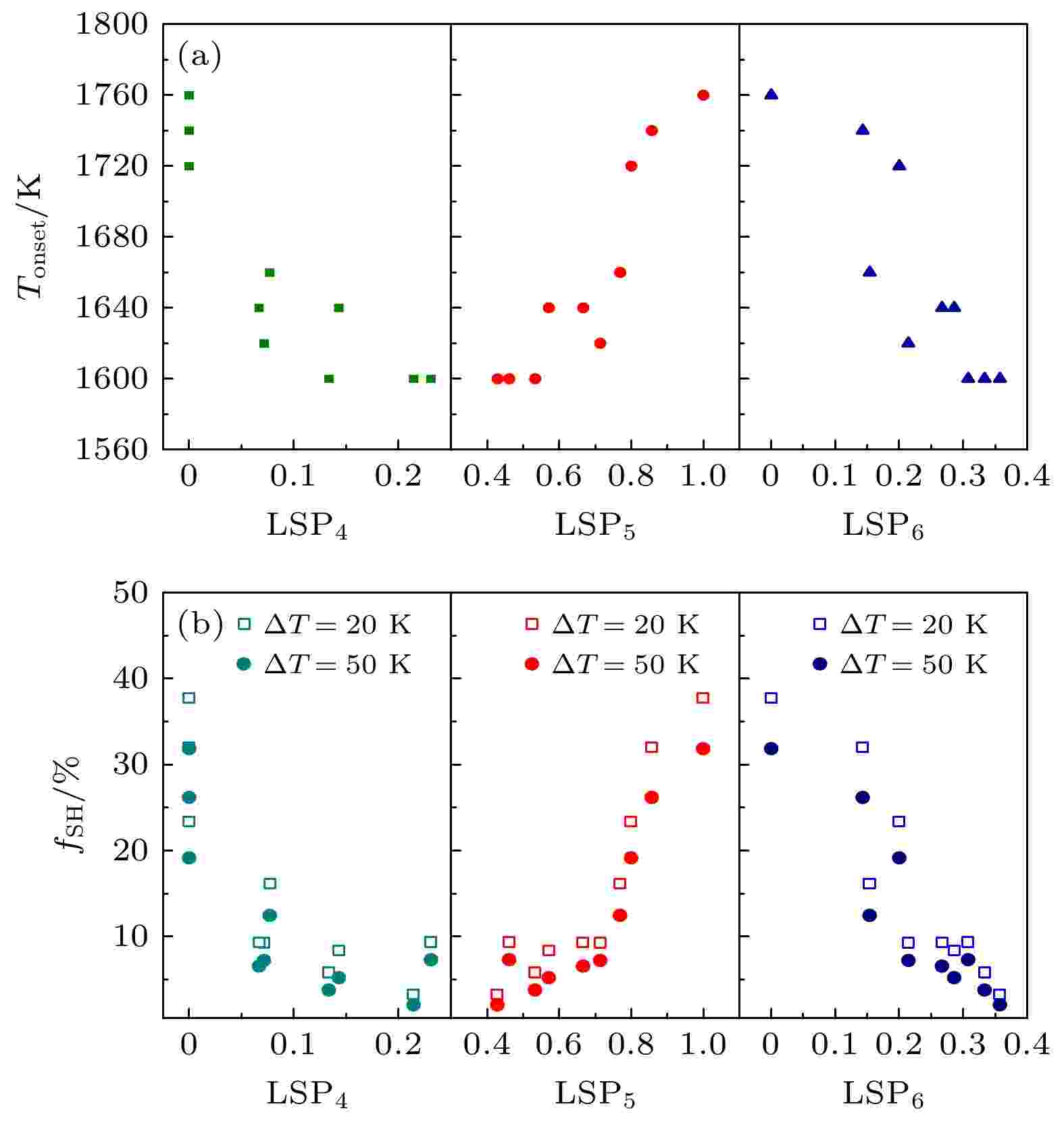
2023, 72 (24): 246101.
doi:10.7498/aps.72.20231153
Abstract +
Metallic glass (MG) has received intensive attention in the fields of amorphous physics and materials science, owing to its excellent mechanical properties, good corrosion resistance, and large elastic deformation limit. Comparing with traditional oxide glass, the limited glass-forming ability (GFA) seriously restricts the application of MG in engineering. Therefore, the GFA has been a hot scientific issue in the field of amorphous material research. Recently, scientists have fully realized that GFA is closely related to the local atomic structure in liquid as well as its evolution features. Since the MG is called the “freezing” liquid, exploring the correlation of local atomic structures between liquid phase and solid phase under rapid solidification conditions is helpful in understanding the microstructural mechanism of GFA. Therefore, the rapid solidification process of liquid Ta is investigated via molecular dynamics simulation. The pair correlation function (PDF), the largest standard cluster (LSC), and the reverse atomic trajectory tracking methods are used to characterize and analyze the microstructure and its evolution during the rapid solicitation of liquid Ta. The results show that the local atomic configurations of the rapidly solidified Ta are various Kasper clusters as well as their distorted configurations, among of which [1/444, 10/555, 2/666] deformed icosahedron (or Z13 cluster) accounts for the highest proportion. The trend of hereditary ability of clusters revealed by the onset temperature of continuous heredity is consistent well with that by the fraction of staged heredity. The geometric symmetry of clusters can be quantitatively characterized by using the local symmetry parameter (LSP). The hereditary ability of clusters is closely related to their LSP. The local five-fold symmetry is beneficial to enhancing hereditary ability, while local four- and six-fold symmetry are disadvantageous for that. The probability of clusters with the same LSC index emerging in the energy range follows the Gaussian distribution, and the expected average atomic potential energy
$ {E}_{\rm exp}^{j} $
is almost linearly related to the LSP, and
$ {E}_{\rm exp}^{j} $
decreases with the increase of LSP5. The high local five-fold symmetry reduces the average atomic potential energy of LSC, thereby enhancing its configurational heredity. These findings have guiding significance in improving GFA through regulating the local symmetry of liquid monatomic metals or alloys.
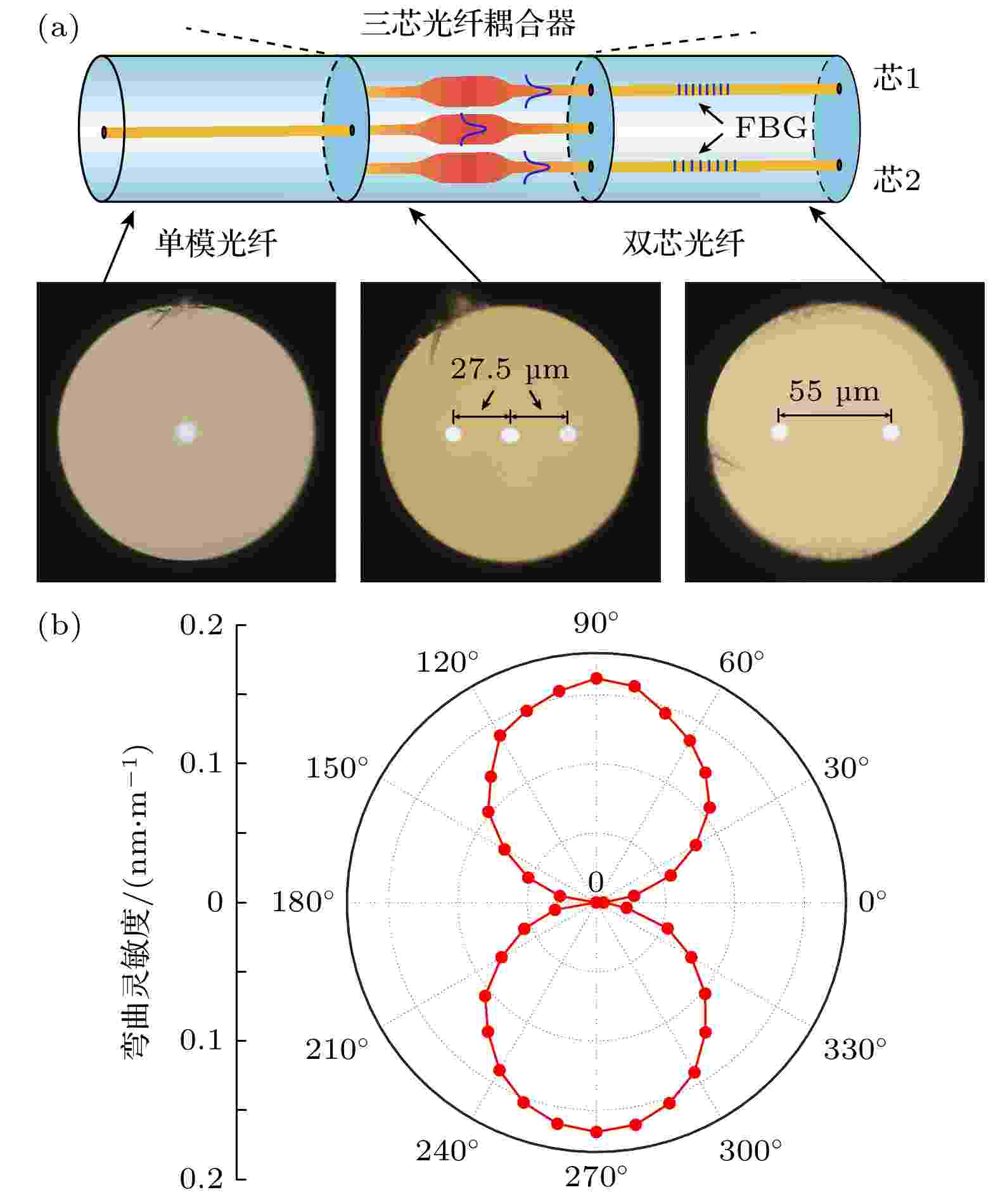
2023, 72 (24): 246601.
doi:10.7498/aps.72.20230204
Abstract +
For discrete optical systems integrated into optical fibers, the optical fields of the individual waveguides are coupled and correlated with each other. This paper studies how to adjust the refractive index of discrete waveguides by thermal diffusion, so as to enhance the coupling between discrete waveguides, and also constructs the discrete waveguide thermally diffused model and the thermally diffused coupling model of twin-core and three-core fibers. The multicore fiber is heated different times by a hydrogen-oxygen flame, and the outgoing light field at the end face of the optical fiber is monitored at the same time. Then, the three-dimensional refractive index measurement results of the thermally diffused multicore fiber verify the feasibility of thermal diffusion technology to change the refractive index of discrete waveguides for coupling. Thermal diffusion technology can be used to fabricate multicore fiber couplers. By combining multicore fiber and core-by-core inscribed fiber Bragg grating technology and by using thermal diffusion technology, the single-channel sensing measurement can be realized. The method of changing the refractive index of discrete waveguides through thermal diffusion has the advantages of high integration, high stability, and mass fabrication. The research on the thermal diffusion of discrete waveguides can improve the application potential of multicore fiber sensing systems, and promote the broad application of discrete waveguide structure optical fiber in the fields of optical communication, optical sensing, biomedicine, and artificial intelligence.
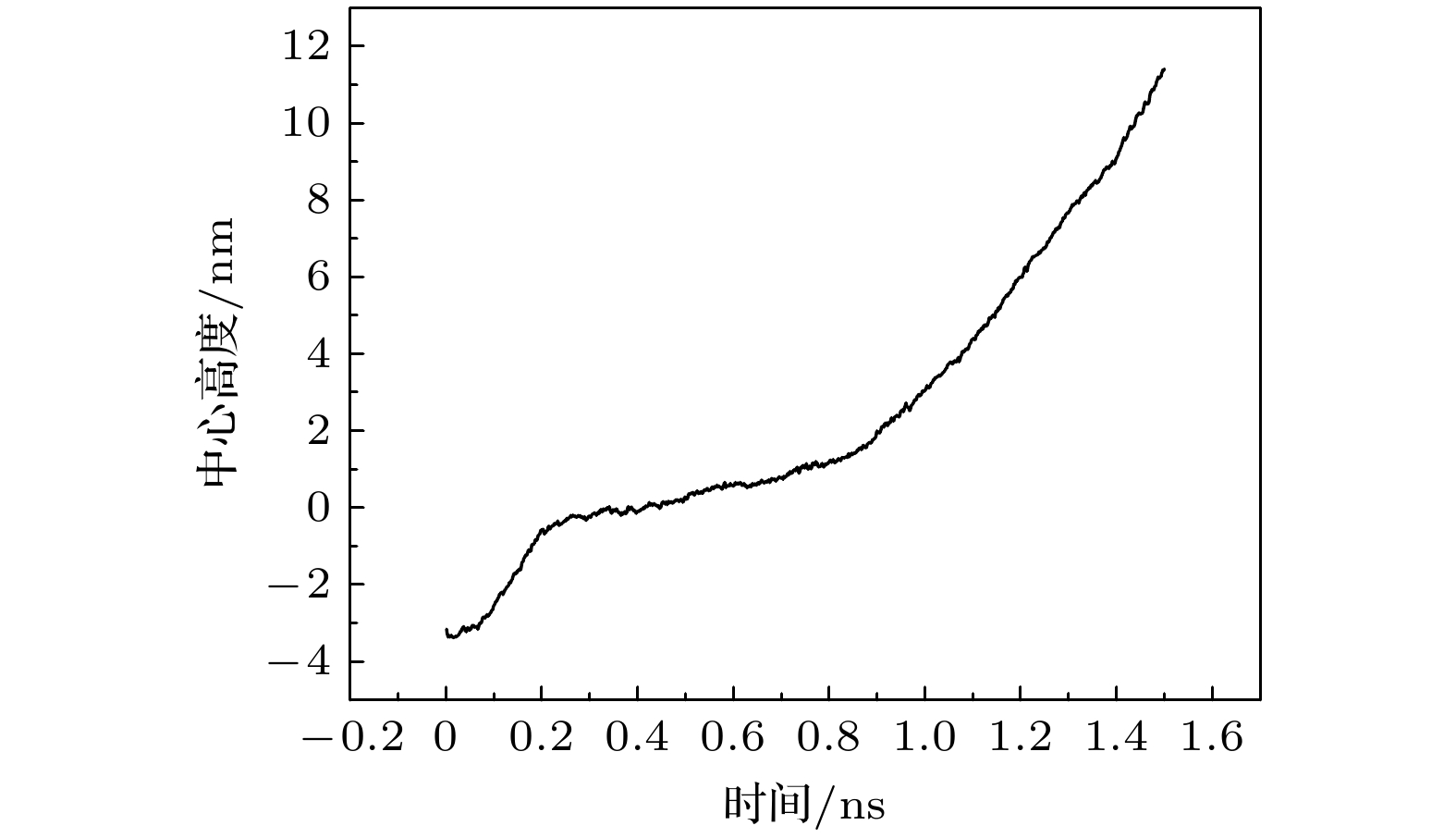
2023, 72 (24): 246801.
doi:10.7498/aps.72.20231120
Abstract +
Up to now, the analysis has rarely been conducted of thermal-mechanical mirror buckling behavior of freestanding graphene membranes discovered in scan tunneling microscope experiments. One of the potential applications of the out-of-plane deformational behavior of graphene membranes is energy harvesting system. Whether in the experiments or for energy harvesting systems, the size of graphene membrane needs to be down to micron scale. According to previous researches, traditional molecular dynamics method is a suitable method to characterize nano-scale mirror buckling. However, owing to the limit of algorithm, when dealing with micro size model by molecular dynamics method, two problems arise: low computational efficiency and too long calculation time. Therefore, for analyzing the mirror buckling of micro size graphene membranes, the coarse-grained molecular dynamics method is utilized in this work. Graphene membranes with a fan-shaped cross section and various depth-span ratios are under mechanical or thermal loads. Effects of each factor on the mirror buckling are investigated. The calculations indicate that for graphene membranes with various depth-span ratios under mechanical load mirror buckling can be observed. And the critical loading increases with the depth-span ratio increasing. Under thermal load graphene membranes only with low depth-span ratios can undergo complete flipping phenomenon. For high depth-span ratio graphene, the center height decreases with temperature rising. However, it is hard to flip over completely. The understanding of the effects of various factors on the mirror buckling phenomenon of graphene membranes can provide theoretical guidance for designing the energy harvesting systems.
CONDENSED MATTER: ELECTRONIC STRUCTURE, ELECTRICAL, MAGNETIC, AND OPTICAL PROPERTIES
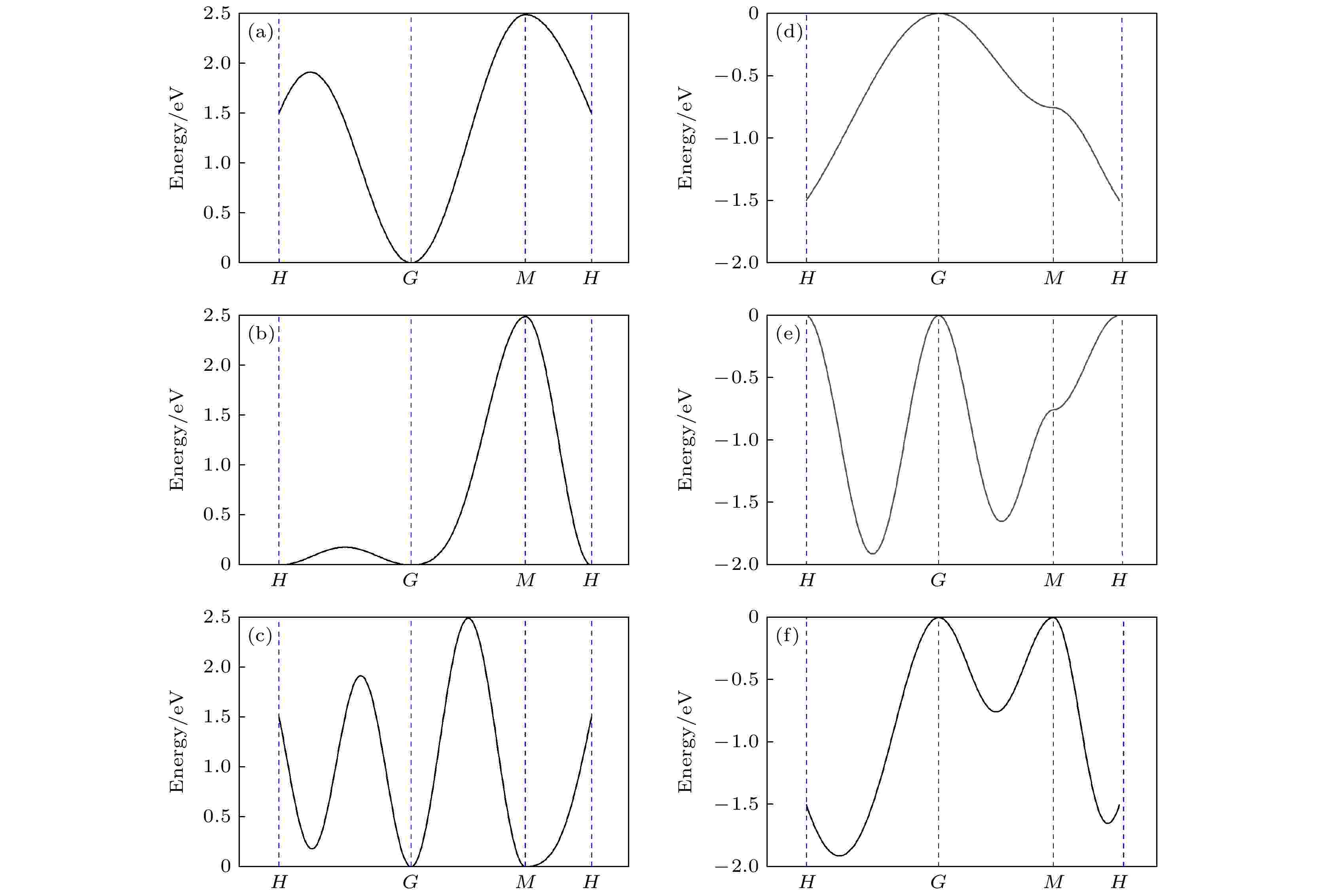
2023, 72 (24): 247101.
doi:10.7498/aps.72.20230909
Abstract +
Kitaev interactions, which are bond-related anisotropic interactions induced by spin-orbit coupling (SOC), may produce quantum spin liquid states in two-dimensional (2D) magnetic hexagonal lattices such as RuCl3. Generally, the strong SOCs in these materials come from heavy metal elements such as Ru in RuCl3. In recent years, some related studies have shown the presence of Kitaev effects in some 2D monolayers of ortho-octahedral structures containing heavy ligand elements, such as CrGeTe3and CrSiTe3. However, there are relatively few reports on the Kitaev interactions in 2D monolayer 1Tstructures. In this paper, we calculate and analyse the atomic and electronic structures of 1T-CoI2and the Kitaev interactions contained therein by the first-principles calculation program VASP. The structure of 1T-CoI2is a triangular lattice with an emphasis on the coordinating element I. The energy dispersion relation
$ {E}_{{\mathrm{S}}}\left(\boldsymbol{q}\right)={E}_{{\mathrm{N}}+{\mathrm{S}}}\left(\boldsymbol{q}\right)-{E}_{{\mathrm{N}}}\left(\boldsymbol{q}\right) $
for the contained Kitaev action is isolated by calculating the energy dispersion relation
$ {E}_{{\mathrm{N}}}\left(\boldsymbol{q}\right) $
for the spin-spiral of monolayer CoI2without SOC and the energy dispersion relation
$ {E}_{{\mathrm{N}}+{\mathrm{S}}}\left(\boldsymbol{q}\right) $
considering SOC by using the generalized Bloch condition combined with the spin-spiral method. The parameters of the Heisenberg exchange interaction induced by the SOC are obtained by fitting the dispersion law of the
$ {E}_{{\mathrm{S}}}\left(\boldsymbol{q}\right) $
to the Kitaev exchange interaction with the parameters of the Kitaev exchange interaction. The fitted curves obtained with the fitted parameters are in good agreement with the calculated values, indicating the accuracy of our calculations. Calculated fits show that the monolayer CoI2is dominated by Heisenberg action, with the third nearest neighbour having the largest absolute value ofJat –1.81 meV. In addition to this, there are strong Kitaev interactions in the monolayer CoI2, whereΓ1reaches 1.09 meV. We predict that the Kitaev interactions are universally applicable to transition metal triangular lattices with 1Tstructure. It is shown that the CoI2can be used as an alternative material for Kitaev and lays a theoretical foundation for exploring Kitaev interactions in other 2D magnetic materials.

EDITOR'S SUGGESTION
2023, 72 (24): 247301.
doi:10.7498/aps.72.20231286
Abstract +
In the non-reciprocal Su-Schrieffer-Heeger (SSH) chain, the hopping amplitude of an electron in the intra-cell depends on its hopping direction. Consequently, the non-Hermitian SSH chain has both non-trivial topological edge state and non-Hermitian skin effect. However, how to detect the non-trivial topological edge states and non-Hermitian skin effect has become an important topic in non-Hermitian physics. In this paper, we study the relationships of the non-trivial topological edge states and the non-Hermitian skin effect of non-Hermitian SSH chain with their electron transport properties in the vicinity of the zero energy. It is demonstrated that when the peak value of the electron transmission probability in the vicinity of the zero energy is much smaller than 1, the non-Hermitian SSH chain has a left-non-Hermitian skin effect; while that in the vicinity of the zero energy is much larger than 1, the non-Hermitian SSH chain has a right-non-Hermitian skin effect. In particular, the skin effect of non-Hermitian SSH chain can be further enhanced in the region of non-trivial topological edge states. Moreover, with the increase of the electron tunneling coupling amplitudes between the non-Hermitian SSH chain and the left and right leads from the weak coupling regime to the strong coupling one, the number of the dips of reflection probability in the vicinity of the zero energy will change from two to zero. Therefore, these results theoretically provide an alternative scheme for detecting non-trivial topological edge states and non-Hermitian skin effect types of the non-Hermitian SSH chain.

EDITOR'S SUGGESTION
2023, 72 (24): 247502.
doi:10.7498/aps.72.20230921
Abstract +
Transition metal phthalocyanine molecules serve as building blocks for two-dimensional (2D) metal-organic frameworks with potential applications in optics, electronics, and spintronics. Previous theoretical studies predicted that a two-dimensional transition metal phthalocyanine framework with kagome lattice (kag-TMPc) has stable magnetically ordered properties, which are promising for spintronics and optoelectronics. However, there is a lack of studies on their heterojunctions, which can effectively tune the properties through interlayer coupling despite its weak nature. Here we use the density functional theory (DFT) to calculate the electronic properties of eight representative 2D kag-TMPc vertical heterojunctions with two different stackings (AA and AB) and interlayer distances. We find that most of the kag-MnPc-based heterojunctions can maintain the electronic properties of monolayer materials with low bandgap. The kag-MnPc/ZnPc is a ferromagnetic semiconductor with magnetic exchange energy above 40 meV, regardless of stacking sequences; the electronic properties of kag-MnPc/MnPc heterojunctions change from magnetic half-metal to magnetic semiconductor during the transition from AA stacking to AB stacking. Interestingly, the AB stacked kag-CuPc/CoPc heterojunction is a ferromagnetic semiconductor, and the spin-polarized energy band arrangement changes with the layer spacing: when the layer spacing is as long as the equilibrium distance, the spin-up and spin-down energy bands are aligned as type II; when the layer spacing increases by 0.2 Å, the spin-up energy bands are aligned as type-I energy bands, while the spin-down energy bands are aligned as type-II energy bands. This distance-dependent spin properties can realize magnetic optoelectronic “switching” and has potential applications in new magnetic field modulated electromagnetic and optoelectronic devices.
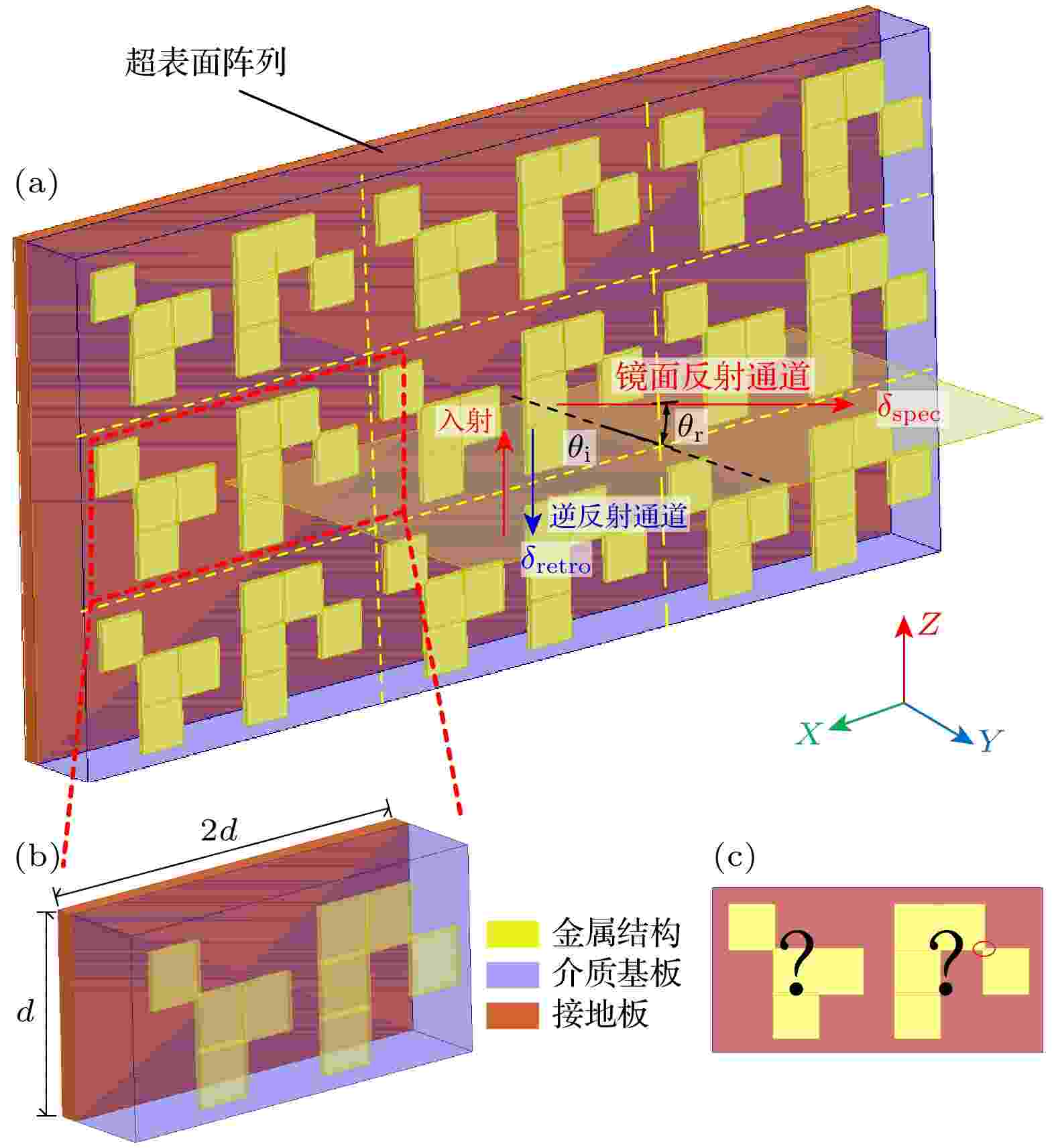
2023, 72 (24): 247801.
doi:10.7498/aps.72.20230775
Abstract +
For oblique incident electromagnetic waves, the generation of double reflection channels including retroreflection channel is of great significance in improving target recognition performance and navigation performance. In double channel reflection, controlling the ratio of retroreflection to specular reflection is the key to realizing reflection power distribution. In order to realize the control of the proportion of the reflected power in each channel, a topology optimization method for designing the reflective metasurface microstructure with dual channel is proposed in this paper. The implementation mechanism is investigated, physical model of metasurface with dual reflection channel including retroreflection channel is established, and the topology optimization model of metasurface microstructure with specific power ratio of the retroreflection to specular reflection is established. As a numerical example, a dual channel metasurface reflector with a 1∶1 ratio of retroreflection power to specular reflection power is designed for a 10 GHz plane wave in the TE mode with a pitch angle of –30°. The designed metasurface exhibits strong directionality in the retroreflective direction, and the reflection amplitudes in both directions are similar. The retroreflective metasurface with the maximum retroreflection ratio is designed. The retroreflection ratio of the designed metasurface is 0.093. There is no specular reflection or other singular reflection, and the strong reflection on the metasurface is concentrated at –30°. The ratio of the main beam power to the total reflection power is 0.900. The simulated and experimental results verify the feasibility of the proposed method.
INTERDISCIPLINARY PHYSICS AND RELATED AREAS OF SCIENCE AND TECHNOLOGY

2023, 72 (24): 248501.
doi:10.7498/aps.72.20231232
Abstract +

2023, 72 (24): 248502.
doi:10.7498/aps.72.20231382
Abstract +
Reducing the space charge effect and the time dispersion caused by the edge field effect of the scanning deflection system is the key to realizing a 100-fs streak tube. In this paper, a novel fs streak tube is proposed and designed. The factors affecting its temporal resolution are analyzed theoretically and the specifications are given. Parameters including the electric field distribution and electron transmittance of the two common acceleration systems (planar cathode-mesh accelerating electrode and planar cathode-slit accelerating electrode) are compared with each other and analyzed theoretically. The results show that although the electric field distribution formed by the planar cathode (mesh accelerating electrode) can form uniform electric field, the electron transmittance is very low; planar cathode-slit accelerating structure will defocus the photoelectron beam along the scanning direction, but the electron transmittance in the effective detection range of the cathode is as high as 100%. The defocusing of the photoelectron beam can be removed by setting a narrow slit in front of the anode. The focusing electrode adopts two sets of plate-like structures which are vertically positioned in front and back to form a one-dimensional focusing electric fields along the scanning direction and the slit direction, respectively. The spatial focusing electrode is arranged close to the phosphor screen, which is beneficial to pushing back the cross-point of the electron beam along the spatial direction. Thus, the electron transit time dispersion in the condition of large electron density will decrease. At the same time, the anode can provide a post-accelerating voltage of +5000 V, which is beneficial to shortening the transit time and dispersion of the photoelectrons, thereby improving the temporal resolution. Based on the above theoretical analysis, a novel femtosecond streak tube is designed by using the planar cathode-slit accelerating electrode, anisotropic focusing system and post-accelerating method. The influence of the anode slit width on the spatial and temporal resolution is simulated. The results show that the temporal resolution deteriorates with the increase of the anode slot width (10-50 μm), due to the fact that the increase of the anode slit width will lead to the gradual increase of the size of the electron spot along the scanning direction, which will lead to the increase of the technical time dispersion. In addition, this study gives the simulation results of the femtosecond streak tube when the anode slit width is in a range of 10-50 μm. The results show that the static spatial resolution is higher than 100 lp/mm at MTF = 10%, dynamic spatial resolution is higher than 29 lp/mm at MTF = 10%, the temporal resolution is better than 122 fs in the range of 4-mm cathode effective detection length. When the effective detection length of the cathode is increased to 8 mm, the dynamic spatial resolution of the streak tube is higher than 22 lp/mm at MTF = 10%, and the temporal resolution is better than 191 fs.
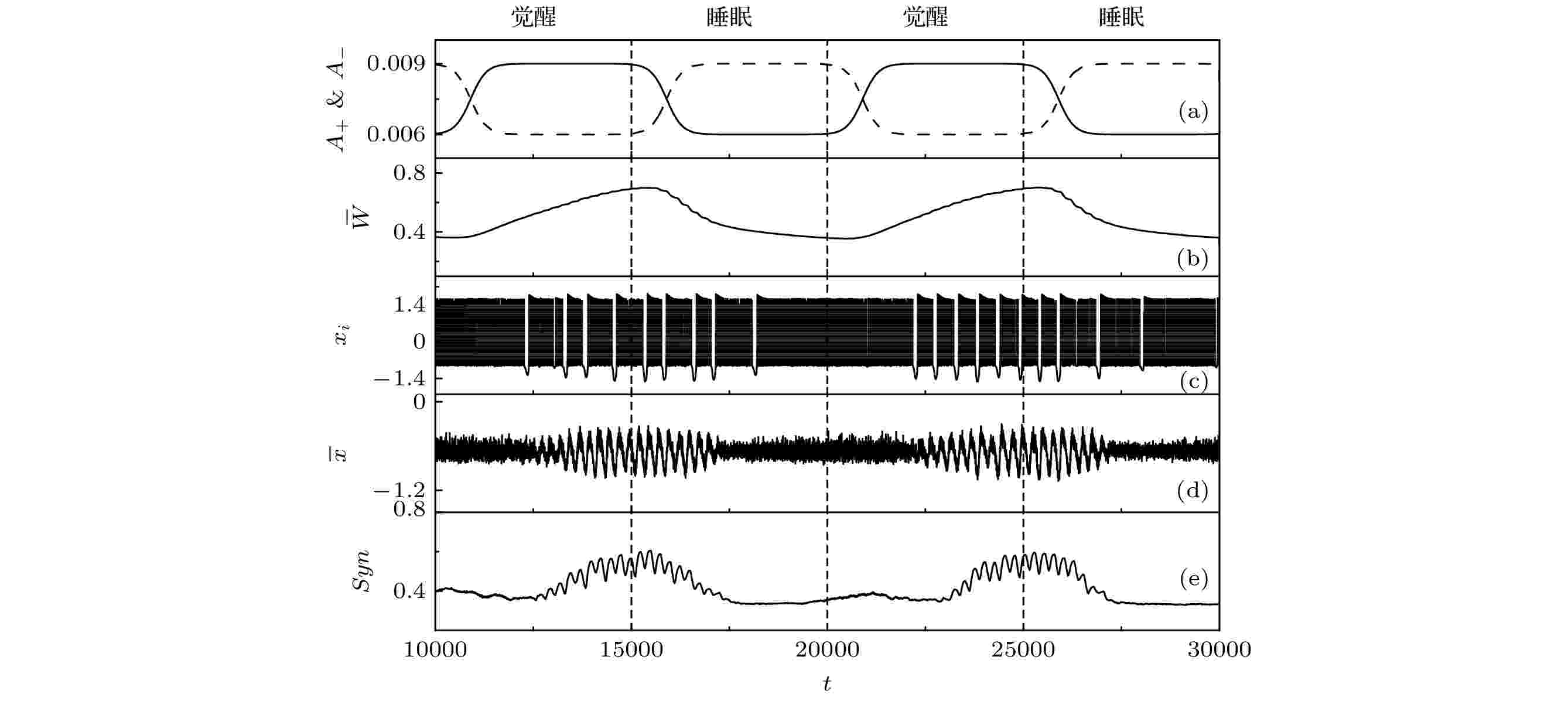
2023, 72 (24): 248706.
doi:10.7498/aps.72.20231037
Abstract +
It has been found experimentally that learning during wakefulness leads to a net enhancement of synaptic strength, accompanied by the neural dynamical transition from tonic to bursting firing, while the net synaptic strength decreases to a baseline level during sleep, accompanied by the transition from bursting to tonic firing. In this paper, we establish a model of synaptic plasticity, which can realize synaptic strength changes and neural dynamical transitions in wakefulness-sleep cycle by using the coupled Hindmarsh-Rose neurons. Through numerical simulation and theoretical analysis, it is further found that the average synaptic weight of the neural network can reach a stable value during either prolonged wakefulness or prolonged sleep, which depends on the ratio of some specific parameters in the model. Particularly, the synaptic weight exhibits a stable log-normal distribution observed in a real neural system, when the average synaptic weight reaches a stable value. Moreover, the fluctuation of this weight distribution is positively correlated with the fluctuation of noise in the synaptic plasticity model. The provided model of the synaptic plasticity and its dynamics results can provide a theoretical reference for studying the physiological mechanism of synaptic plasticity and neuronal firings during the wakefulness-sleep cycle, and they are expected to have potential applications in the development of therapeutic interventions for sleep disorders.
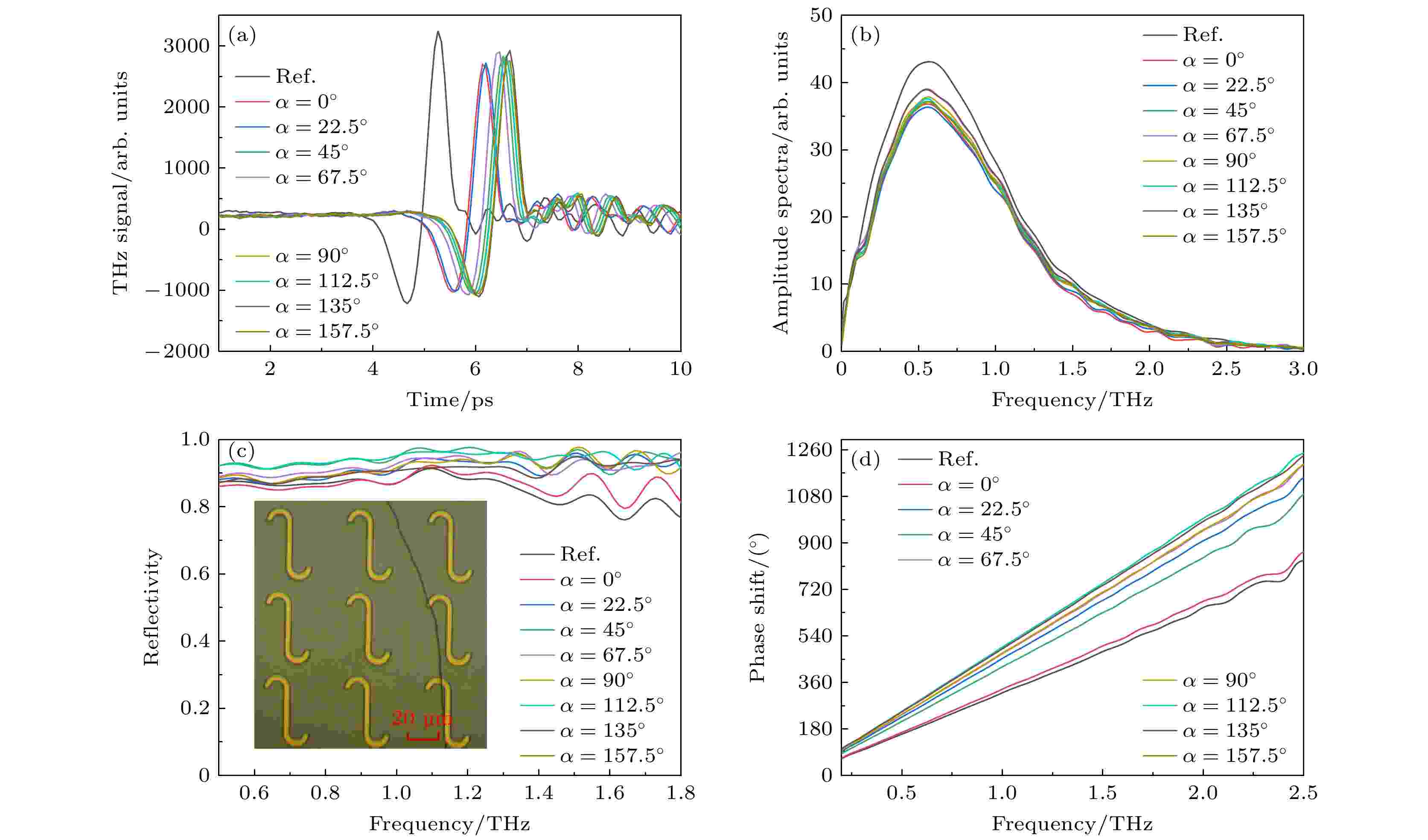
2023, 72 (24): 248707.
doi:10.7498/aps.72.20230989
Abstract +
Multi-dimension and multi-freedom modulation of polarization state based on the geometrical-phase periodic encoding metasurface has important application prospects. Here, terahertz metasurface composed of specially shaped metal pattern coded particles is proposed. When the coded particles are normally incident, the amplitude reflectivity of the terahertz wave is above 80% in a range of 0.50–1.80 THz. Combined with the Pancharatnam-Berry (P-B) phase theory, 8 kinds of coded particles are designed by rotating the angle of the designed unit. Three kinds of 1-bit, 2-bit, and 3-bit periodic encoding metasurfaces with different encoding sequences are used to manipulate the reflected terahertz waves splitting into multiple-beam with different deflection angles. In addition, both reflection characteristics (including amplitude, phase, and phase coverage) of all coded particles and the angle deflection of the designed 2-bit periodic metasurface are measured by normal incidence THz time-domain spectrometer and variable incident angle THz time-domain spectrometer, respectively. Based on generalized Snell law and experimental results, the reason for the discrepancy between theoretical value and experimental value is further analyzed, which can provide a reference for the reverse design of the coded metasurfaces to meet various practical needs.
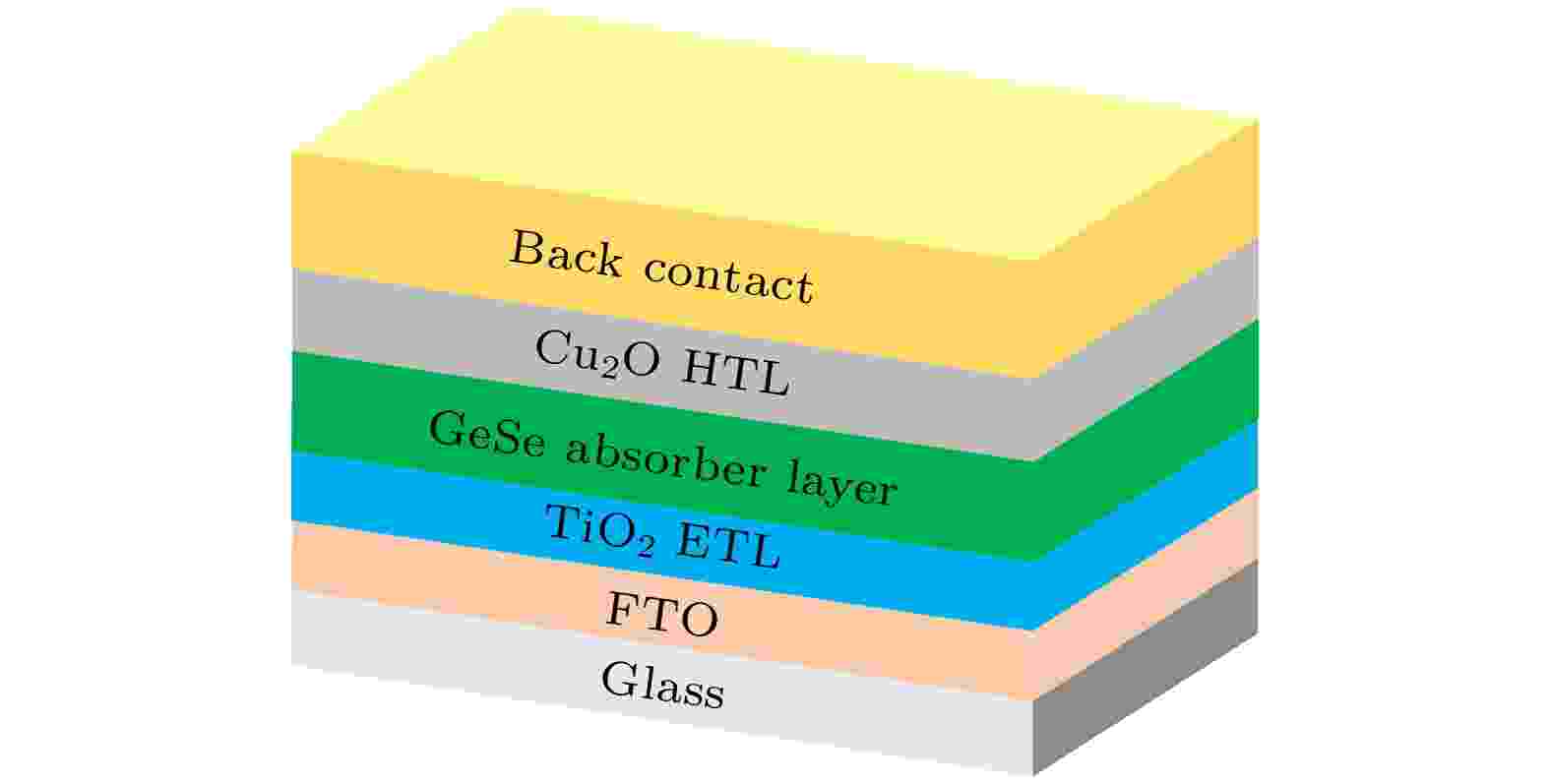
2023, 72 (24): 248801.
doi:10.7498/aps.72.20231220
Abstract +
One of the research hotspots in thin film solar cell technology is to seek the suitable absorber layer materials to replace cadmium telluride and copper indium gallium selenium. Recently, germanium selenide (GeSe) with excellent photoelectric property has entered the field of vision of photovoltaic researchers. The main factors affecting the performance of heterojunction solar cell are the material properties of each functional layer, the device configuration, and the interface characteristics at the heterostructure. In this study, we utilize GeSe as the absorber layer, and assemble it with stable TiO2as electron transport layer and with Cu2O as hole transport layer, respectively, into a heterojunction solar cell with the FTO/TiO2/GeSe/Cu2O/Metal structure. The TiO2and Cu2O can form small spike-like conduction band offset and valence band offset with the absorber layer, respectively, which do not hinder majority carrier transport but can effectively suppress carrier recombination at the heterointerface. Subsequently, the wxAMPS software is used to simulate and analyze the effects of functional layer material parameters, heterointerface characteristics, and operating temperature on the performance parameters of the proposed solar cell. Considering the practical application, the relevant material parameters are selected carefully. After being optimized at 300 K, the proposed GeSe heterojunction solar cell can reach an open circuit voltage of 0.752 V, a short circuit current of 40.71 mA·cm–2, a filling factor of 82.89%, and a conversion efficiency of 25.39%. It is anticipated from the results that the GeSe based heterojunction solar cell with a structure of FTO/TiO2/GeSe/Cu2O/Au has the potential to become a high-efficiency, low toxicity, and low-cost photovoltaic device. Simulation analysis also provides some references for designing and preparing the heterojunction solar cells.

2023, 72 (24): 248802.
doi:10.7498/aps.72.20231055
Abstract +
The preparation of traditional organic-inorganic lead-halogen hybrid perovskite solar cells often requires strict nitrogen glove box conditions, thus hindering their industrial scalability. This study develops a large-area perovskite film formation process and designs a novel device structure to achieve a dual enhancement of module device efficiency and stability in a high humidity air environment (55%). High-quality perovskite thin films are successfully prepared by vacuum extraction in ambient air, followed by a double-end low-temperature photopolymerization process utilizing acrylate monomer molecules for inner encapsulation modification of the freshly formed perovskite thin films. The influences of these techniques on the photoelectric characteristics of perovskite thin films and devices are investigated. The results indicate that uniform and dense perovskite films can be achieved in ambient air with a pumping time of 60 s. By adjusting the concentration of ethylene glycol dimethacrylate monomer molecules used in the low-temperature photopolymerization process, the surface defects on the perovskite film can be effectively controlled. The optimal concentration of 1 mg/mL results in perovskite film with optimal morphology and fluorescence intensity. Furthermore, rigid module device and flexible module device (effective area: 18 cm²), based on the polymer inner encapsulation, demonstrate outstanding outdoor photoelectric conversion efficiencies of 19.51% and 18.17%, respectively (with the highest indoor low-light conversion efficiencies of 34.5% and 30.2%, respectively). Notably, the untreated flexible device exhibits a significant decline in photoelectric conversion efficiency, falling below 50% of the initial value after one month of exposure to air. In contrast, device incorporating the polymer inner encapsulation layer maintains over 90% of their original efficiency, highlighting their excellent humidity resistance stability. Moreover, the polymer encapsulation layer also greatly improves the bending stability of the flexible device. This research paves the way for industrial-scale producing perovskite solar cells and addressing the challenges associated with humidity and large-area fabrication. The findings contribute to advancing perovskite solar cell technology and offering a pathway for high-efficiency and stable devices suitable for practical applications.



























